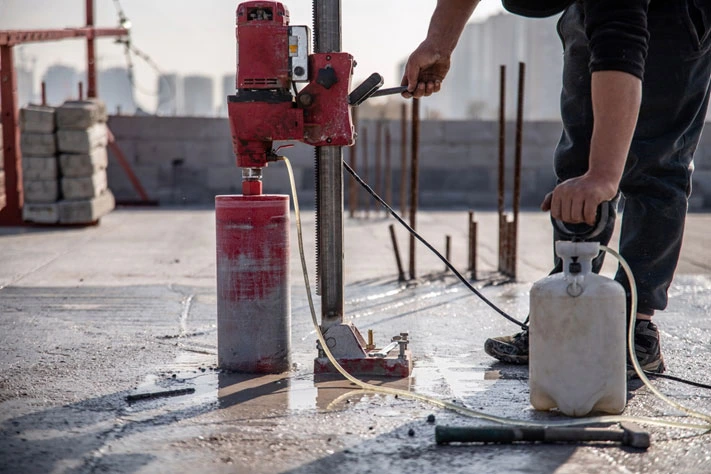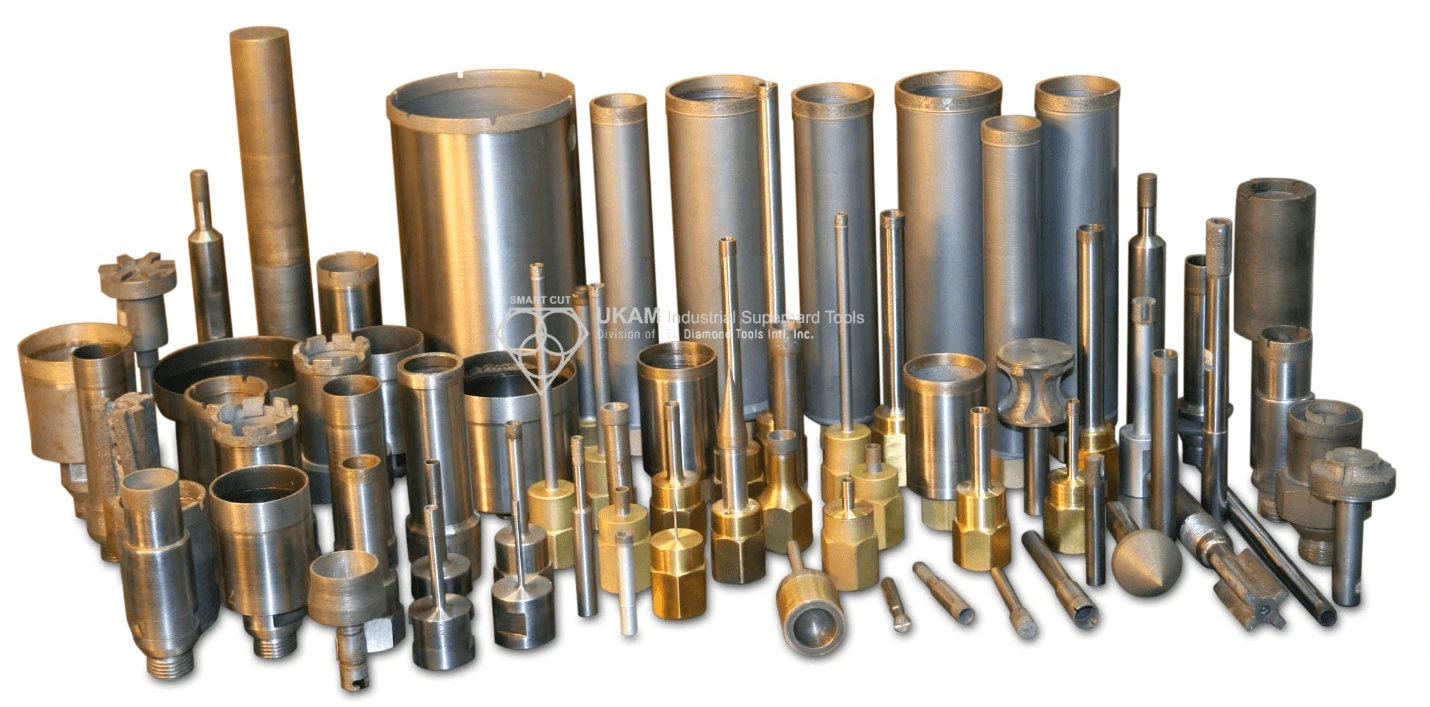Diamond Core Bit Ultimate Guide
-
Posted by
 Brian Farberov
Brian Farberov

Table of Contents
ToggleDiamond Core Bits for Concrete & Construction are available in countless of specifications. Diamond core bits, known for their unmatched durability and cutting ability, are a necessity for professionals needing to drill through reinforced concrete, masonry, and other tough construction materials.
Share this Article with Friend or Colleague
This guide serves as a comprehensive resource for understanding diamond core bits within the context of concrete and construction. Whether you’re involved in infrastructure projects, building foundations, or specialized drilling tasks, selecting the right diamond core bit is essential to achieving optimal results. In this guide we will explore the key components of diamond core bits, such as their diamond segments, bonding materials, and barrel designs, and explain how these factors influence drilling performance in various conditions.
Diamond Core Bit Diameter
Diamond core bit diameter specifications are an important consideration when choosing the right tool for drilling concrete, asphalt, and other construction materials. The diameter of a core bit refers to the width of the hole it creates and can significantly affect performance, drilling speed, efficiency, and the overall outcome of the project.
Core bit diameters vary widely to accommodate different applications.
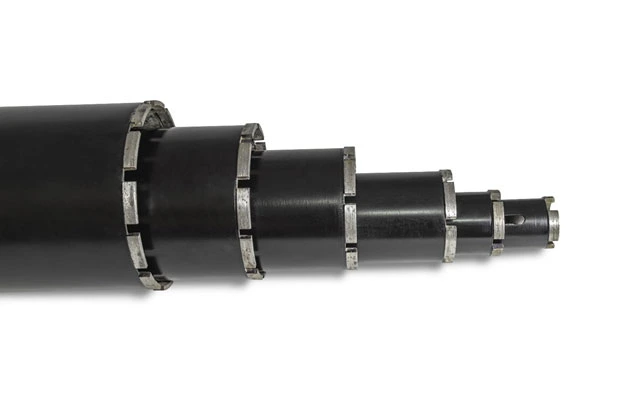
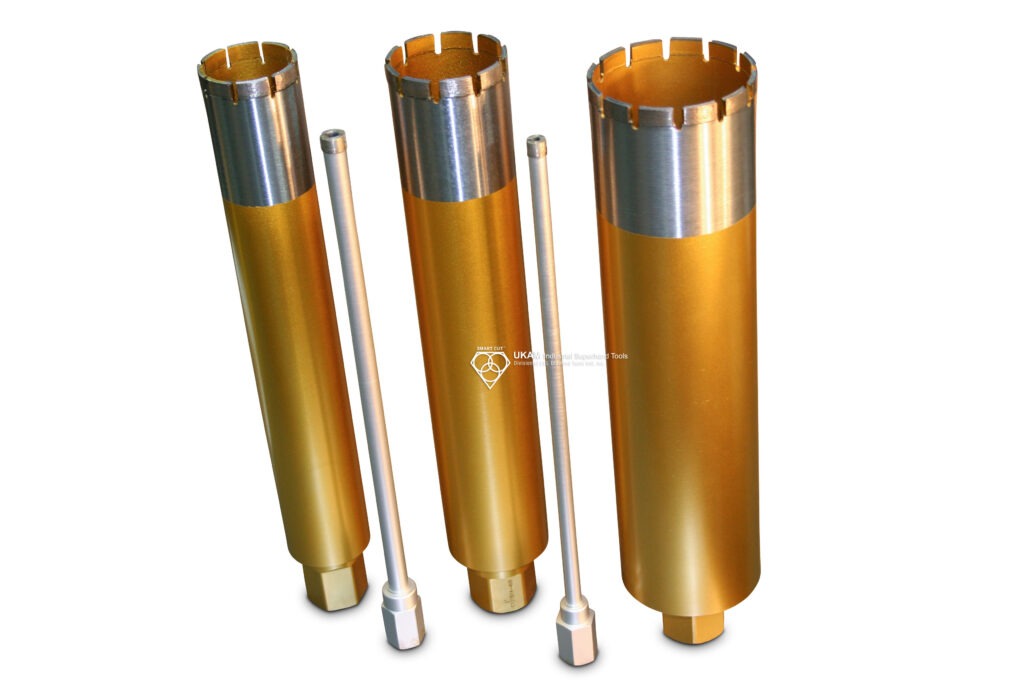
Smaller diameter bits
such as those ranging from 1/4 inch to 2 inches, are often used for precise, smaller-scale tasks like installing anchor bolts, pipes, or conduits. These bits are generally easier to control, allowing for more accurate and detailed work. They also produce less debris, making them suitable for lighter, less demanding applications. The smaller size also allows for higher drilling speeds since there is less material to remove, reducing overall friction. However, they may wear out faster due to the concentrated load on a smaller cutting surface.
Medium-sized diameters
typically ranging from 2 inches to 6 inches, are commonly used for more general construction tasks such as core sampling, plumbing installations, or creating openings for electrical conduit and HVAC systems. These bits offer a balance between precision and durability, providing efficient drilling performance without compromising accuracy. In terms of performance, medium-diameter bits can maintain higher speeds while still offering the durability required for heavier-duty drilling into concrete or asphalt. Their versatility makes them a staple in construction projects that require both strength and precision.
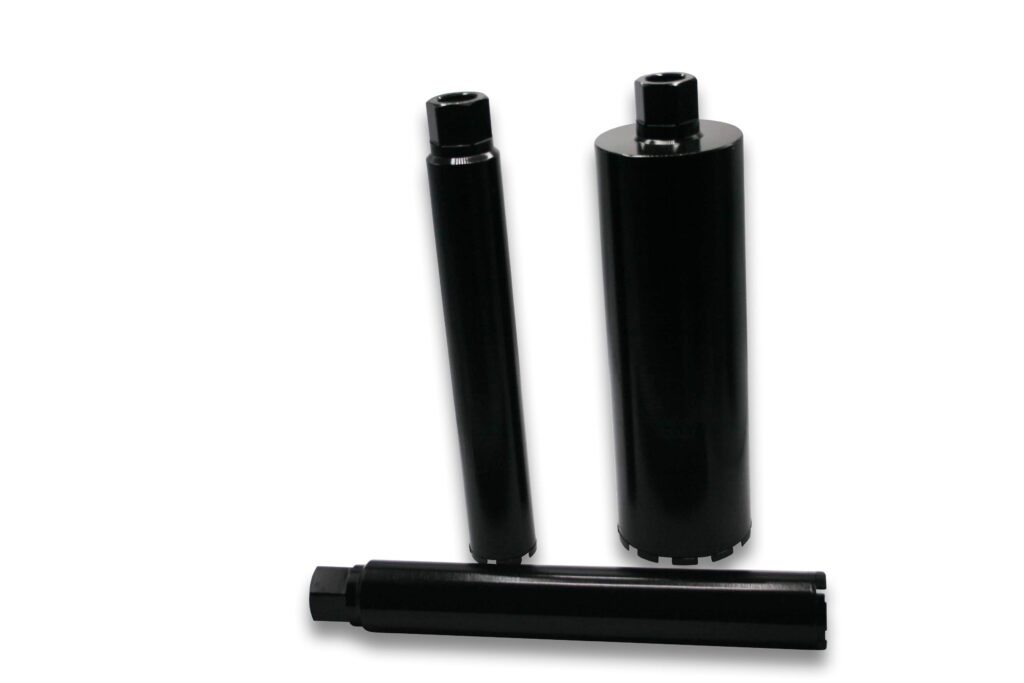
Larger diameter bits
ranging from 6 inches to over 24 inches, are used for more demanding applications, such as cutting large holes in walls, floors, or pavements for utility installations, as well as for core drilling large pipes or structural openings. These large bits are typically used with high-powered drilling rigs due to the torque required to maintain steady drilling pressure over larger areas. The larger surface area of these bits means they cut through more material at a slower pace, generating more friction and heat. However, larger core bits are designed for durability, with thicker diamond segments and a sturdier construction to withstand the high-stress conditions of large-diameter drilling. This durability ensures that they can be used for extended periods on tough materials like reinforced concrete or asphalt.
The diameter of the core bit affects not only the size of the hole but also the amount of debris generated during the drilling process. Larger diameters produce more dust and slurry, which requires effective cooling and cleaning mechanisms to maintain efficient cutting performance and prevent overheating. Water cooling is typically used for these larger bits to manage the increased heat and friction generated during prolonged drilling.
Drilling speed is another factor influenced by the diameter of the core bit. Smaller diameter bits tend to drill faster because there is less material to remove, resulting in lower resistance. However, as the diameter increases, drilling speed tends to decrease due to the larger surface area in contact with the material. This increased contact area requires more power and a slower rotation speed to ensure that the bit cuts effectively without wearing down too quickly.
In addition to performance, the selection of core bit diameter can also impact tool lifespan. Larger diameter bits generally have thicker diamond segments, allowing for a longer usable life, especially when drilling into hard materials like concrete or asphalt. The increased segment height provides more cutting material, which can withstand more wear and tear before needing replacement. Conversely, smaller diameter bits with thinner segments may wear out faster, particularly when used on abrasive materials.
The choice of diameter must also align with the type of material being drilled. Concrete and asphalt, for instance, require different considerations when selecting the appropriate bit diameter. Concrete, especially when reinforced with rebar, presents more resistance, meaning larger bits require more power and durability to cut through both the concrete and the embedded steel. Asphalt, while softer than concrete, still requires strong, durable bits to handle the heat generated during cutting, especially for larger diameters used in road construction or utility installations.
Diamond Core Bit Segment Attachment Methods
Diamond core drills are typically made by attaching diamond segments, which perform the cutting, to a steel core or body. The method used to attach these segments can significantly impact the drill's performance, durability, and suitability for different applications.
One common method is brazing, which involves using a filler metal, or braze alloy, to join the diamond segment to the steel core.
The filler metal is heated until molten, then allowed to cool, bonding the diamond segment to the drill body. This method provides a strong bond, especially when done correctly, and is a cost-effective and widely used option. However, the high temperatures involved in brazing can sometimes damage the diamonds, reducing their cutting efficiency. Additionally, brazed bonds may not be ideal for high-demand applications, as the bond may wear out faster under heavy use.
Another method is laser welding, which uses a laser to fuse the diamond segment directly to the steel core.
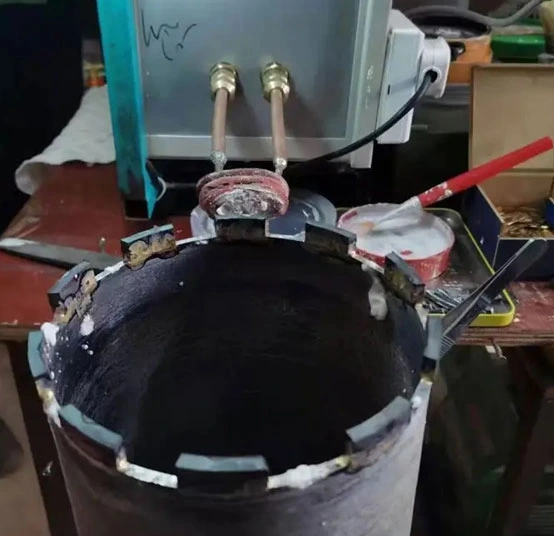
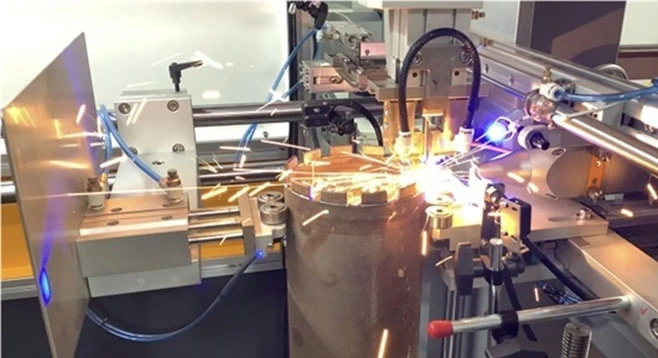
The laser generates a high-energy beam that melts a small portion of both the segment and the core, creating a robust bond. This method results in an extremely strong connection, making it suitable for demanding applications. Laser welding does not require a filler metal, so there is a direct bond between the diamond segment and the drill body. Additionally, the localized heat reduces the risk of diamond damage. However, laser welding is more expensive due to the specialized equipment and expertise required, and it is not as widespread as brazing, which means it might not be available for all drill types or sizes.
Here's a table comparing brazing and laser welding as methods for attaching diamond segments to a steel core in diamond core drills:
|
Aspect |
Brazing |
Laser Welding |
|---|---|---|
|
Process |
Uses a filler metal (braze alloy) to join the diamond segment to the steel core by heating the metal until molten, then cooling to form a bond. |
Uses a high-energy laser to fuse the diamond segment directly to the steel core by melting a small portion of both materials. |
|
Bond Strength |
Strong when applied correctly, but less durable for high-demand applications. |
Extremely strong, suitable for demanding applications. |
|
Heat Impact |
High temperatures may damage the diamonds, potentially reducing their cutting efficiency. |
Localized heat reduces the risk of diamond damage. |
|
Cost |
Cost-effective and widely used. |
More expensive due to specialized equipment and expertise required. |
|
Durability |
Adequate for general applications, but bond may wear out faster under heavy use. |
Highly durable, ideal for high-stress and high-demand environments. |
|
Availability |
Widely available and suitable for most drill types and sizes. |
Less widespread, may not be available for all drill types or sizes. |
|
Filler Metal |
Requires a filler metal (braze alloy). |
No filler metal required; creates a direct bond. |
|
Applications |
Suitable for standard and cost-conscious applications. |
Best for high-demand, high-performance applications. |
Diamond depth / height for diamond core bits
The diamond depth, or height, for diamond core drills refers to the height of the diamond segment bonded to the core drill’s body, which is responsible for the actual cutting. This height is critical as it determines the drill's usable life before it requires replacement or refurbishment.
Standard heights for diamond segments can vary, with many diamond core bits featuring heights between 5mm and 10mm. Specialized drills may have shorter or taller segments depending on the application. The diamond segment height directly affects how much material can be drilled before the diamonds wear away and the drill becomes ineffective. A greater diamond height generally indicates a longer usable life, but this also depends on factors like the hardness and abrasiveness of the material being drilled, the drilling speed, and the cooling or lubrication methods employed.
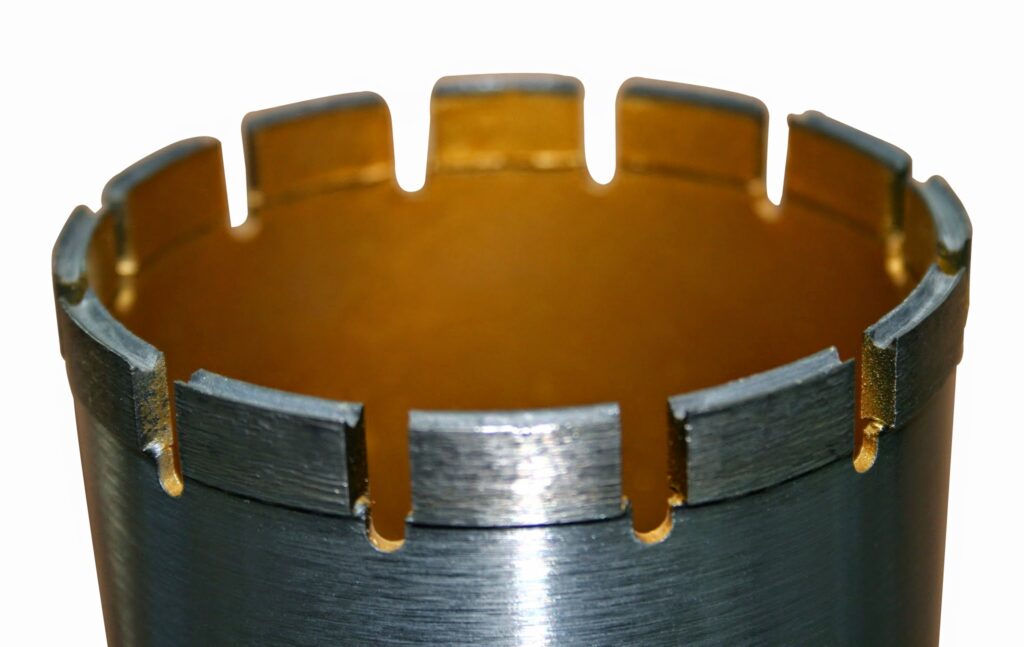
In terms of cost, drills with a greater diamond segment height may have a higher initial price due to the added diamond and bonding materials. However, their extended life can result in cost savings, particularly in high-volume applications. The bonding matrix, whether metal, resin, or another type, plays a role in wear rate. Some matrices are designed to wear faster, exposing fresh diamond grit to maintain sharpness. For optimal life and performance, the segment height should be matched with the right bond for the material being drilled.
When drilling very hard materials, a taller diamond segment may be advantageous as these materials can cause rapid wear. For softer or more abrasive materials, such as certain types of concrete, the composition of the bonding matrix may be more important than the segment height.
The performance characteristics of the drill can also be influenced by the segment height. Taller segments may improve heat dissipation due to their larger surface area, though they could also introduce more vibration or instability if not properly balanced.
Diamond Core Bit Drilling Depth
One of the most important considerations when selecting and using a diamond core bit is its ability to handle specific drilling depths. This factor directly impacts the success of the operation, the tool's longevity, and overall project efficiency.
Drilling depth refers to the maximum distance a diamond core bit can penetrate into materials such as concrete or reinforced concrete. Achieving the desired depth with precision is crucial for a range of construction tasks, including installing pipes, conduits, or structural reinforcements, as well as for core sampling or material testing. Several factors contribute to the core bit’s effectiveness in reaching the required depth, including segment design, the quality of the diamonds, the bonding material, and the type of drilling equipment used.
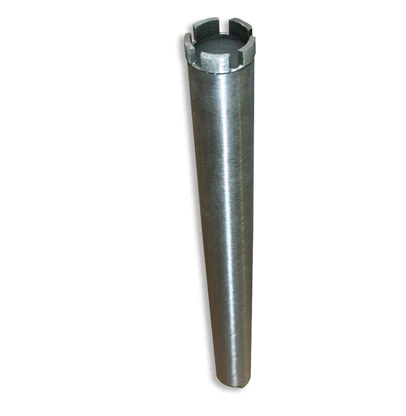
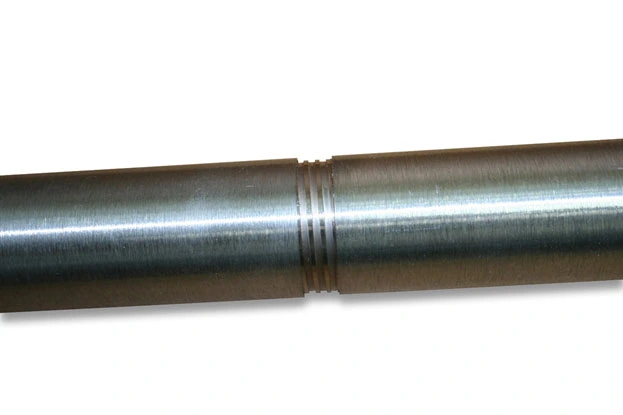
The length or barrel height of the core bit determines the maximum depth it can reach in a single pass. Core bits are manufactured in different lengths to suit a variety of applications, from shallow depth drilling to deep coring. For projects requiring deeper holes, longer core bits are essential. The diameter of the core bit also plays a role in the achievable depth, as larger diameters generally allow for deeper penetration. However, maintaining stability is crucial when drilling deeper, so the balance between diameter and depth must be carefully considered.
The height and composition of the diamond segments on the core bit are critical in determining how well it can perform at greater depths. Higher diamond segments contain more abrasive material, allowing the bit to cut deeper into hard surfaces while maintaining durability. In deep drilling operations, thicker segments offer more cutting material, helping the bit withstand the increased resistance and heat that builds up as it drills further into the material.
Material properties are another factor that affect drilling depth. Concrete and construction materials vary in hardness and density, with reinforced concrete presenting more challenges due to the steel rebar embedded within it. Drilling deeper into such materials increases the friction and heat the bit encounters, as well as the possibility of hitting obstacles like rebar. Specialized core bits are required to handle these conditions smoothly and effectively.
The type of drilling equipment used also affects the maximum achievable depth with a diamond core bit. High-power drilling rigs with strong motors are typically required for deep drilling in materials like concrete, as they provide the necessary torque and consistent cutting pressure. Cooling systems, whether water or air, are also essential when drilling deep to manage heat generation and prevent damage to both the bit and the material. Continuous cooling ensures that the bit operates efficiently and avoids premature wear.
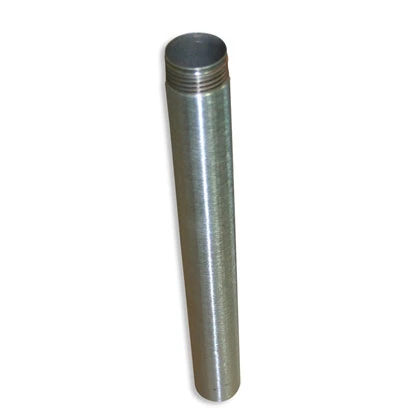
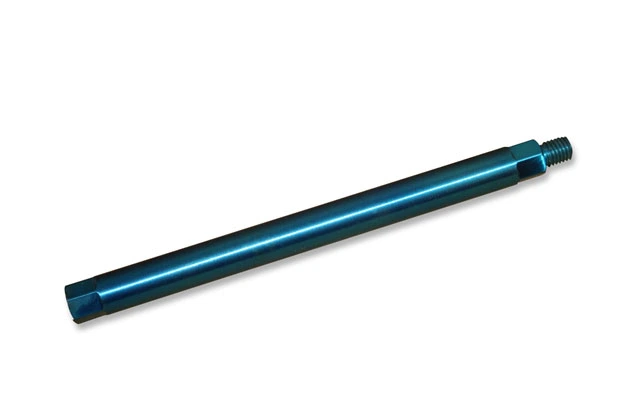
In deeper drilling projects, certain techniques can enhance the performance and ensure successful core extraction. Step drilling, for example, involves drilling in stages, starting with a smaller diameter bit and gradually increasing the size with each pass. This approach reduces stress on the bit and the equipment, making deeper drilling more manageable.
extension rods can also be added to the drill to extend the core bit’s reach, enabling it to drill beyond its standard length without compromising performance.
When drilling through reinforced concrete, encountering rebar at deeper levels is common. Using a core bit designed specifically to cut through rebar ensures that the process remains smooth and that the bit isn’t damaged or worn prematurely.
Maintaining the core bit during deep drilling is essential for preserving its performance. The deeper the drilling, the more wear the diamond segments experience. Proper cooling must be applied throughout the process to minimize heat buildup, which can lead to premature wear or damage. Periodically dressing or sharpening the diamond segments helps restore their cutting efficiency, ensuring that the bit remains effective during prolonged use.
Continuous Rim vs. Segmented Diamond Core Bits
When selecting diamond core bits for concrete and construction applications, one of the primary decisions revolves around whether to use continuous rim or segmented core bits. Both types of bits have distinct characteristics that make them suitable for different tasks, and the choice between the two depends on factors like the material being drilled, the desired cut quality, and operational efficiency.
Continuous rim diamond core bits
Feature a smooth, unbroken rim that contains embedded diamonds along the entire circumference of the cutting edge. This design provides a continuous contact with the material, allowing for a smoother and more precise cut.
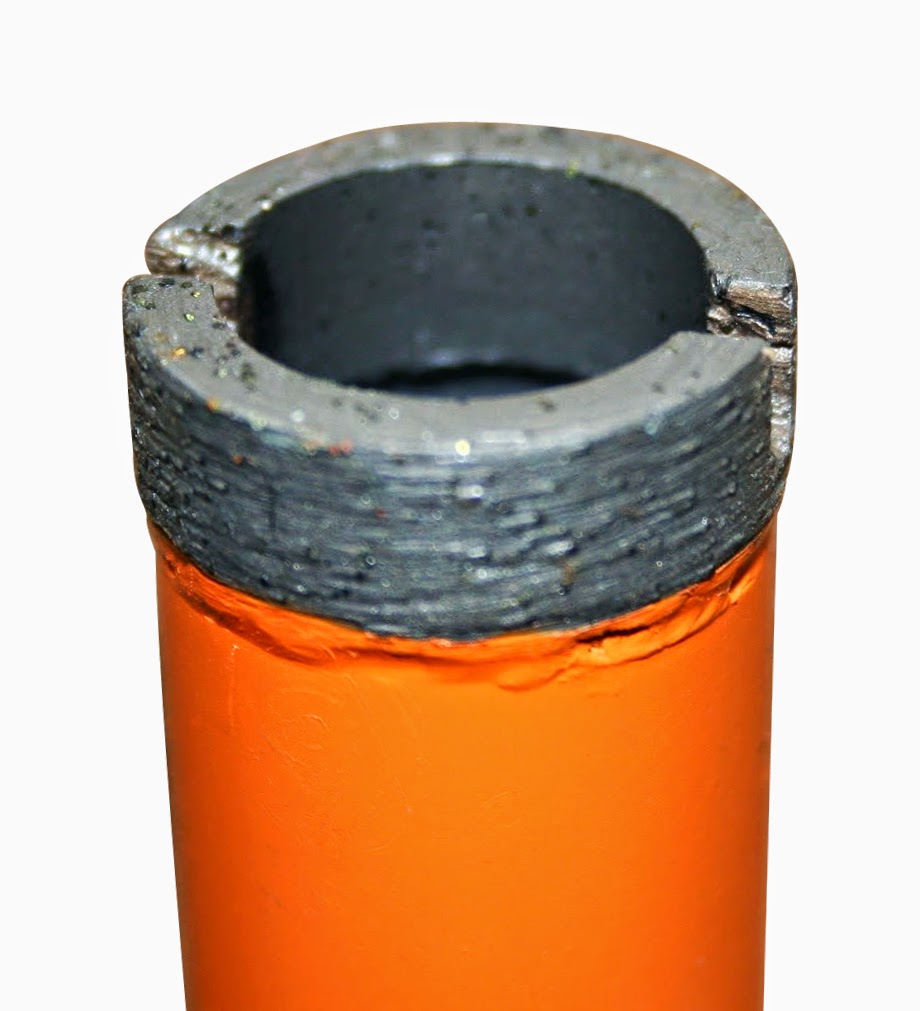

The consistent surface engagement makes continuous rim bits particularly well-suited for applications where minimal chipping or a clean finish is essential, such as drilling in tiles, ceramics, and softer stones. In concrete applications, these bits are often used when the quality of the cut matters, especially in delicate structures or when the drilled hole will remain visible and aesthetics are important. Additionally, continuous rim bits excel in situations where wet drilling is preferred, as the smooth rim performs efficiently when paired with water to reduce friction and manage heat generation.
However, while continuous rim bits provide superior cutting accuracy, they tend to generate more heat due to their continuous contact with the material. This makes them slower when drilling through harder materials like reinforced concrete, as the friction builds up and slows down the cutting process. Consequently, they are best suited for lighter-duty applications or when precision is prioritized over speed.
Segmented diamond core bits
Segmented diamond core bits are designed with individual diamond segments spaced around the cutting edge. These segments create gaps that allow for better cooling and debris removal during drilling, making them ideal for heavy-duty tasks such as drilling into tough materials like reinforced concrete, asphalt, or masonry. The segmented design reduces friction, enabling the bit to cut faster and more aggressively than a continuous rim bit, particularly in hard and abrasive materials. These gaps also help dissipate heat more efficiently, preventing the bit from overheating and extending its lifespan, especially in dry drilling applications.

Segmented bits are generally the preferred choice for larger-scale construction projects where speed and efficiency are critical. Their ability to handle high-stress conditions makes them suitable for tasks such as core drilling through concrete slabs, walls, and foundations. The durability and toughness of segmented bits allow them to cut through not only concrete but also the embedded rebar found in reinforced structures, making them indispensable for structural work. While segmented bits are effective for fast and aggressive cutting, the trade-off is that they may produce rougher edges and more chipping compared to continuous rim bits. This makes them less ideal for applications requiring a fine finish, though in most construction scenarios, the priority is speed and material removal rather than aesthetic perfection.
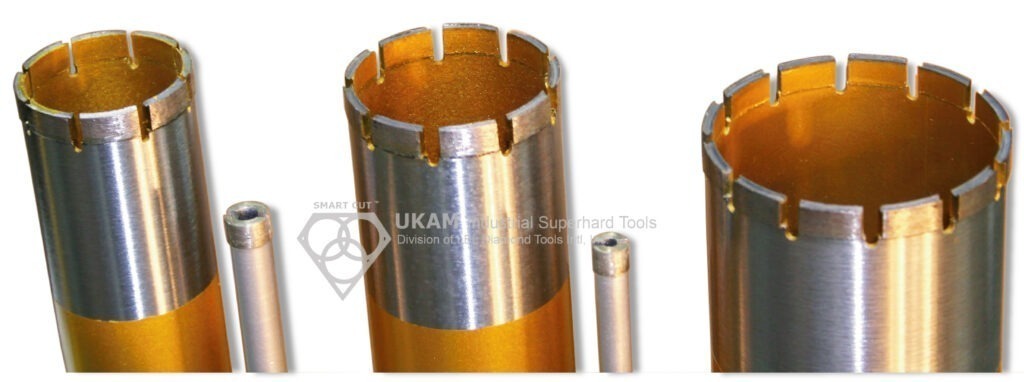
The choice between continuous rim and segmented diamond core bits ultimately comes down to the specific needs of the project. For tasks that demand a smooth finish and precise cuts, such as drilling through tiles, decorative stone, or other delicate materials, continuous rim bits are the better option. However, when drilling into harder, more abrasive materials like concrete, especially in large-scale construction projects, segmented bits offer the durability, speed, and efficiency necessary for getting the job done quickly and effectively.
Table comparing continuous rim and segmented diamond core bits
|
Feature |
Continuous Rim Diamond Core Bit |
Segmented Diamond Core Bit |
|---|---|---|
|
Design |
Smooth, unbroken rim with embedded diamonds across the edge |
Individual diamond segments spaced with gaps around the edge |
|
Cut Quality |
Provides smooth, clean, and precise cuts with minimal chipping |
Produces rougher cuts with more chipping and edge irregularity |
|
Cutting Speed |
Slower due to continuous contact with material |
Faster cutting, especially in hard, abrasive materials |
|
Cooling and Debris Removal |
Less efficient at cooling; requires water for optimal performance |
Better cooling and debris removal due to gaps between segments |
|
Best Application |
Ideal for softer materials or tasks where a fine finish is essential (e.g., tiles, ceramics, softer stones) |
Best for heavy-duty drilling in hard materials like reinforced concrete and asphalt |
|
Durability |
Tends to wear faster in hard materials due to heat build-up |
More durable for tough applications and dry drilling |
|
Heat Dissipation |
Generates more heat, especially in dry conditions |
Efficient heat dissipation, reducing risk of overheating |
|
Dry vs. Wet Drilling |
Typically used for wet drilling to reduce heat and friction |
Suitable for both dry and wet drilling |
|
Reinforced Materials |
Less effective in cutting through rebar or tough concrete |
Excellent for cutting through reinforced concrete and masonry |
|
Cost Efficiency |
Generally less cost-effective for large-scale or high-volume tasks due to slower speeds |
More cost-efficient for high-volume, heavy-duty projects due to faster drilling speeds and durability |
Diamond Core Bit Segmented Designs
Diamond core drills or bits with segments are designed to optimize performance based on the specific material being drilled and the desired outcome. The various types of segment designs each serve a unique purpose, allowing for more efficient drilling in different conditions.
Rooftop or turbo segments feature a pointed, peak-like design on the top of the bit. This shape helps initiate the drilling process by penetrating hard materials more quickly. It also enhances debris removal and cooling, making these segments ideal for fast drilling in materials like concrete, granite, and other hard surfaces. The sharp design ensures quicker penetration and helps maintain a steady cutting speed.
Segmented or serrated segments are another common type. These have serrated or notched edges, which allow for faster drilling and longer tool life.

The serrations create gaps that promote better heat dissipation and debris removal, essential for maintaining cutting efficiency during long periods of use. These segments are versatile, making them a popular choice for general-purpose drilling in a wide range of materials, especially concrete.
T-segmented bits are characterized by their T-shaped segments, which provide a broader cutting surface. This design is particularly useful for smoother drilling and helps reduce the risk of chipping, making it suitable for delicate materials like marble and granite. The wider cutting surface allows for more controlled cutting, offering a smoother finish, which is often critical when working with these types of stones.
Ring-segmented bits feature a continuous ring of diamond segments around the bit. This design allows for fast, smooth drilling, making it suitable for applications where continuous, uninterrupted cutting is required. The ring-segmented structure facilitates a high-speed cutting process without sacrificing precision, making it effective for both hard and softer materials.
Cross or X-segmented bits have segments arranged in a cross or X pattern. This layout provides increased stability during the drilling process and promotes uniform wear across the segments. The design helps balance the cutting forces, making these bits ideal for drilling medium to hard materials where even wear and stability are essential.
Star-segmented bits are designed with segments shaped like a star. The unique configuration allows for faster drilling starts and excellent debris removal, making them versatile tools that can be used on a wide variety of materials. The star shape enables the drill to bite into the material quickly, making it efficient for general-purpose drilling where speed is a priority.
Pilot or crowned segments incorporate a smaller segment at the tip of the core bit, followed by the regular segments. This design helps guide the drill bit accurately into the material, ensuring a precise start to the drilling process. It is particularly useful for drilling delicate materials or in situations where precision is of utmost importance.
Impregnated or matrix segments differ from the others in that they do not have clearly defined segments. Instead, diamond particles are distributed throughout the matrix material of the bit. This design offers consistent performance and wear, as the diamond particles are exposed gradually during the drilling process. These bits are best suited for drilling in very abrasive materials, where maintaining consistent cutting ability over time is critical.
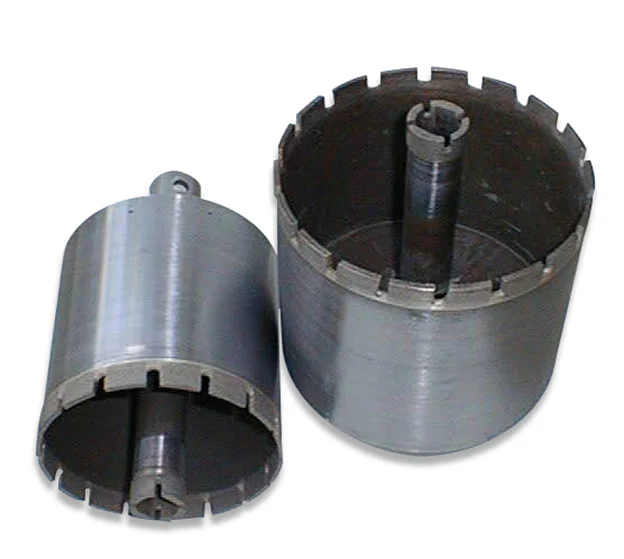
The choice of segment design depends on several factors, including the material being drilled, the type of equipment used, and the desired speed and finish. For example, when drilling hard concrete, a segmented or serrated design might be preferred for its aggressive cutting action. In contrast, for delicate stones like marble, a T-segmented or ring-segmented design would be more appropriate to avoid chipping and achieve a smoother finish.
The spacing between segments and the number of segments on a diamond core bit are also important design considerations. These factors are influenced by the bit’s diameter, the material being drilled, and the specific requirements of the project.
A core bit with more segments generally provides better performance in terms of durability and speed, while the spacing between segments affects heat dissipation and debris removal.
Table comparing different types of diamond segments for core drills based on their design, functionality, and ideal applications:
| Heading #1 | Heading #2 | Heading #3 | Heading #4 |
|---|---|---|---|
|
Segment Type |
Design |
Functionality |
Best For |
|
Rooftop or Turbo Segments |
Pointed or peak-like design on the top |
Facilitates quicker penetration and better debris removal |
Fast drilling in hard materials like concrete and granite |
|
Segmented or Serrated Segments |
Serrated or notched edge |
Provides good speed and longevity; enhances heat dissipation and debris removal |
General-purpose drilling, especially in concrete |
|
T-Segmented |
T-shaped segments with a wider cutting surface |
Offers smoother drilling and reduces chipping |
Delicate materials such as marble and granite |
|
Ring Segmented |
Continuous ring of diamond segments |
Enables fast, smooth, and continuous cutting |
High-speed drilling in various materials |
|
Cross or X Segmented |
Segments arranged in a cross or X pattern |
Improves stability and promotes uniform wear |
Balanced cutting in medium to hard materials |
|
Star Segmented |
Segments shaped like a star |
Allows for fast starts and effective debris removal |
Versatile use in various materials |
|
Pilot or Crowned Segments |
Smaller segment at the tip followed by regular segments |
Assists in accurate guiding for a precise start |
Delicate materials or situations requiring precision |
|
Impregnated or Matrix Segments |
Diamond particles uniformly distributed throughout the matrix |
Offers consistent performance as diamonds are continuously exposed |
Abrasive materials requiring steady wear over time |
Spacing between diamond segments
The spacing between diamond segments on a core drill plays a critical role in the drilling process, influencing both the efficiency of heat dissipation and debris removal. The gaps between the segments are essential for managing the heat generated during drilling and ensuring that dust, debris, or slurry can be easily expelled from the cutting area. This becomes particularly important when drilling harder materials like granite or reinforced concrete, where larger amounts of dust and debris are produced.
In such cases, wider spacing between segments allows for better removal of material, preventing the bit from clogging and maintaining effective cutting performance. Dry diamond core bits have few segments and large spacing between the segments for faster drilling less heat generation
On the other hand, when drilling softer or more abrasive materials like limestone or sandstones, closer spacing might be preferred to ensure consistent wear and more uniform cutting action.
The number of segments on a core bit is typically determined by the bit's diameter and the material being drilled. Larger diameter bits, naturally, accommodate more segments than smaller ones. For instance, a 1-inch diameter core bit might have around 4 segments, whereas a 4-inch diameter bit could feature 12 or more. The hardness of the material being drilled also influences segment count.
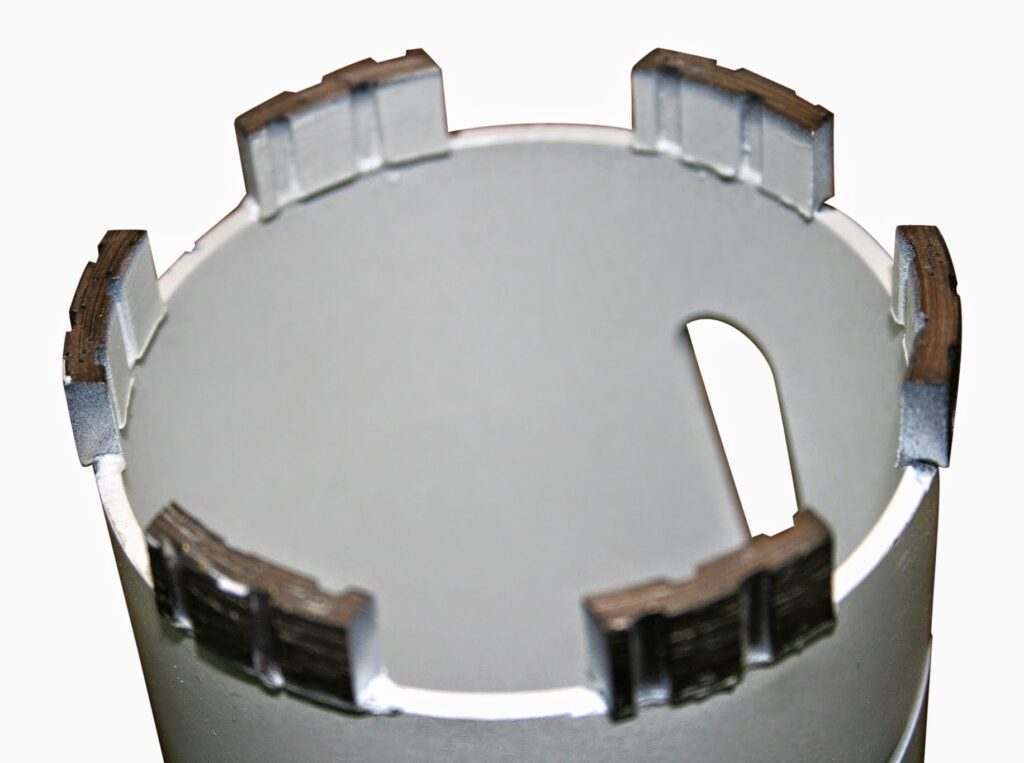
Harder materials benefit from a greater number of segments, which help distribute the workload and heat more evenly across the surface of the bit, thereby extending the life of the segments. In contrast, when working with softer materials, fewer segments may be more effective, as they prevent the bit from becoming overcrowded with cutting edges and ensure debris can be effectively cleared away.
Another important factor to consider is the width of the diamond segments. Narrower segments might be used in larger quantities, while wider segments could be fewer in number. The width of the segments is a key variable that works in conjunction with the number of segments and their spacing. Narrower segments with more spacing can promote faster drilling, while wider segments may provide more stability and durability under certain conditions.

Drilling speed is also affected by the number of segments. A core bit with more segments means that more cutting edges are engaging the material simultaneously, which can result in faster drilling. However, this can also generate more friction and heat, making effective cooling mechanisms essential. Core bits used with water or other cooling fluids typically have different segment configurations compared to those designed for dry drilling, where heat management is more challenging.
The overall lifespan of a core bit is also impacted by the number and spacing of segments. A bit with more segments can potentially distribute wear more evenly, which might increase its lifespan. However, factors such as the hardness of the material being drilled and the specific drilling conditions, including speed and cooling, play significant roles in determining how quickly the segments will wear out.
Diamond Segment kerf thickness
The thickness of the segments on a diamond core bit can vary depending on the design and intended application of the bit. Generally speaking, the segment thickness is determined by factors such as the material to be drilled, the type of equipment used, the desired speed and longevity of the bit, and the overall design of the bit.
Typically, segment thickness for diamond core bits can range from:
The thickness of the diamond segments on a core bit is a critical factor that influences both the performance and lifespan of the bit. The segment thickness is determined by several variables, including the material being drilled, the type of drilling equipment, the required cutting speed, and the intended longevity of the tool. A well-chosen kerf thickness can optimize the balance between precision, cutting speed, and durability.
Ultra Thin Wall Thickness, 0.5mm to 1.5mm
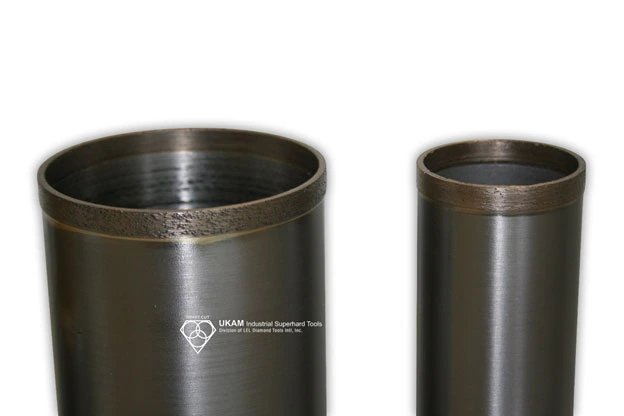
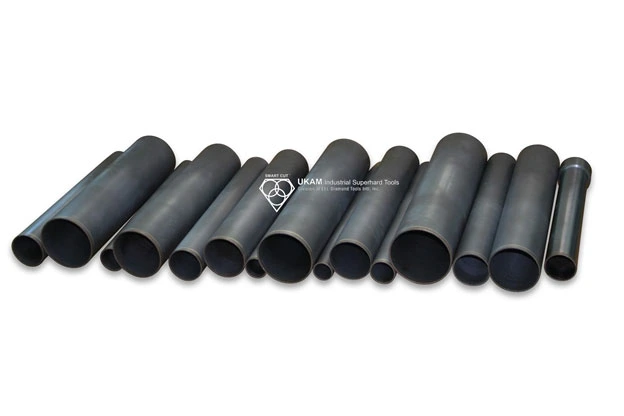
Thin kerf thickness is usually 2mm to 3mm
used for more delicate operations, such as drilling softer materials or achieving a precise, fine finish, thinner diamond segments are typically used. These are ideal for applications like drilling tiles or softer stones where the accuracy of the cut is important. However, due to their thinner profile, these diamond core bits tend to wear out more quickly, especially when used on harder or more abrasive materials. This makes them more suited to light-duty applications where finesse is prioritized over durability.
General-purpose drilling, diamond segment thickness typically ranges from 3mm to 5mm
This range provides an effective compromise between cutting efficiency and tool longevity. These medium-thickness segments are commonly used for a variety of materials, including concrete, masonry, and a range of stones. The added thickness compared to the finer segments ensures a longer lifespan while still maintaining relatively high cutting speeds. These segments are versatile and are widely used in construction and other fields where moderate drilling speeds and durability are required.
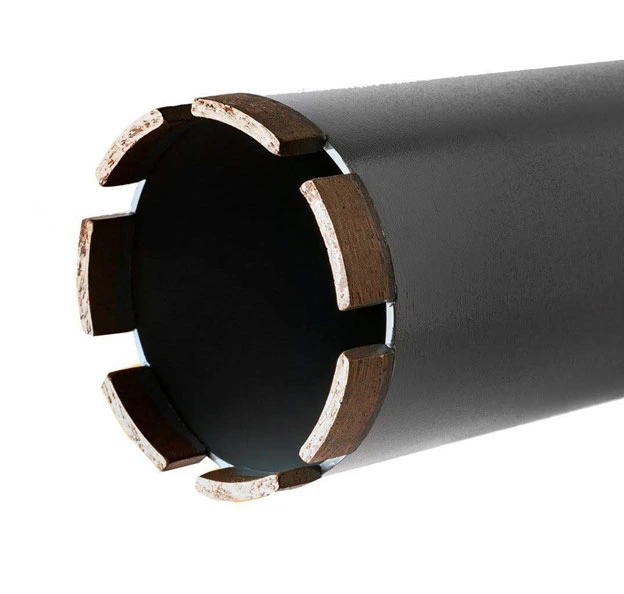
Thicker diamond segments, which measure from 5mm to 10mm or more, are designed for heavy-duty applications. These segments are often found in industrial and construction settings, where the materials being drilled are particularly hard or abrasive, such as reinforced concrete, granite, or certain types of hard stones. The additional thickness allows the bit to endure more wear and tear, providing a longer service life. However, the trade-off for this increased durability is typically a reduction in cutting speed. Thicker segments create more friction during drilling, which can slow down the process, especially when used on harder materials.
The segment’s thickness also plays a direct role in the overall longevity of the bit. Thicker segments contain more diamond and bonding material, meaning they can withstand a greater degree of wear before becoming unusable. However, thicker segments require more energy to cut through materials, which may result in slower drilling speeds. In situations where efficiency and speed are crucial, such as in high-output construction projects, operators may need to find a balance between segment thickness and desired drilling speed.
Other factors that influence the choice of kerf thickness include the type of bond used in the segment, the diameter of the core bit, and the specific demands of the job. For example, bits with a metal bond tend to last longer, but may require a thicker kerf to compensate for the slower wear rate. Additionally, core bits with larger diameters may require thicker segments to provide enough cutting surface for the increased torque and power generated by larger drilling machines.
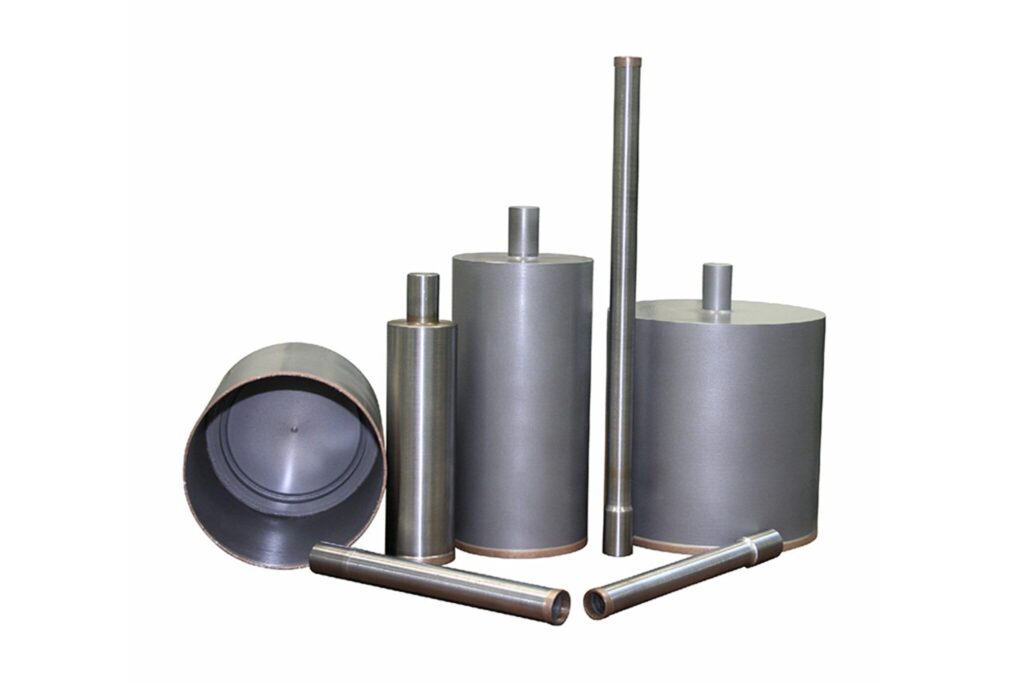
Ultimately, the selection of diamond segment thickness should be tailored to the specific application, material, and operational requirements. While thicker segments offer longer life and better performance for tough jobs, thinner segments are better suited for precision work where a fine finish and higher speed are required.
Table comparing different diamond segment thicknesses based on their design, performance, and applications:
|
Segment Thickness |
Design Characteristics |
Performance |
Best For |
Lifespan |
Speed |
|---|---|---|---|---|---|
|
2mm to 3mm |
Thinner segments, ideal for delicate operations |
Provides high precision but wears out faster due to the thinner profile |
Softer materials, tiles, finer stones where precision and finish are key |
Shorter lifespan due to thinner material |
Faster cutting speed due to lower friction |
|
3mm to 5mm |
Medium thickness, general-purpose segments |
Balances cutting performance and durability |
Concrete, masonry, and a variety of stones; suitable for general-purpose use |
Moderate lifespan with balanced performance |
Moderate speed with good wear resistance |
|
5mm to 10mm |
Thicker segments designed for heavy-duty applications |
Longer service life but slower cutting due to increased friction |
Hard, abrasive materials like reinforced concrete, granite, and hard stones |
Longer lifespan, higher durability |
Slower cutting speed due to thicker segments |
|
10mm or more |
Extra-thick segments for extreme durability in tough jobs |
Maximum durability and extended wear for the most demanding tasks |
Industrial and construction settings with very hard materials |
Longest lifespan, suitable for industrial use |
Slowest cutting speed due to high friction |
Radius or Angle of Segments
The radius or angle of the segments on a diamond core bit refers to the shape or geometry of the segment’s cutting edge. These profiles are carefully engineered to meet the demands of specific applications, drilling conditions, and materials. The design of these segments plays a crucial role in determining the efficiency, speed, and quality of the drilling process.
Flat Segment
this is the most common shape, characterized by a rectangular or square profile. This design is widely used for general-purpose drilling, offering reliable cutting performance across a variety of materials such as concrete, masonry, and stone. The flat segment provides consistent results and is favored for its versatility in handling standard drilling tasks.
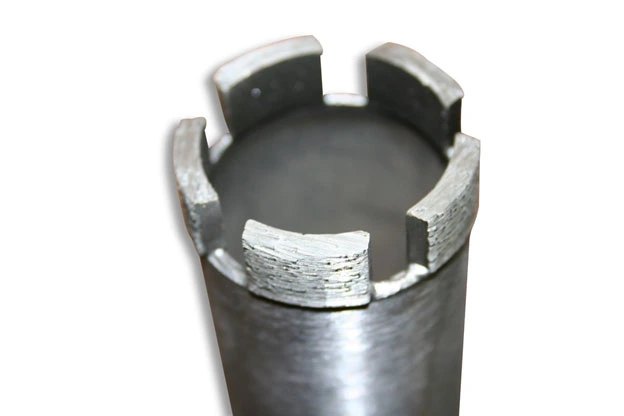
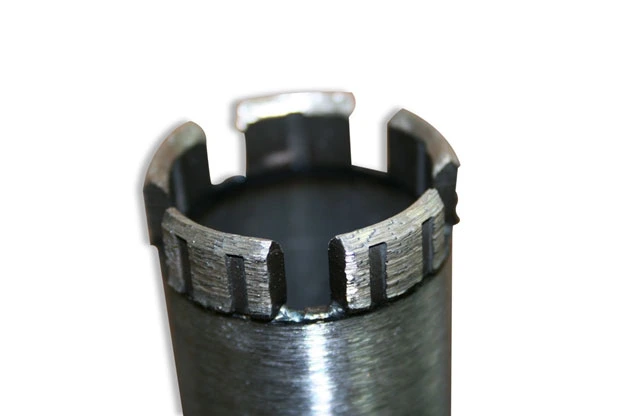
Roof Top or Turbo Segments
distinguished by their pointed or peak-like profile, are designed for fast drilling and quick starting in harder materials. The sharp, pointed geometry of these segments allows for rapid penetration, making them ideal for materials such as granite or reinforced concrete, where quick and aggressive cutting is required. The roof top profile also helps in breaking through tough surfaces more efficiently.
Rounded or Convex Segments
For applications requiring a smoother cut with minimal chipping. These segments have a curved cutting edge that engages the material more gently, reducing the risk of damage. This profile is ideal for drilling delicate materials like marble or ceramics, where maintaining surface integrity and avoiding chipping are important considerations.
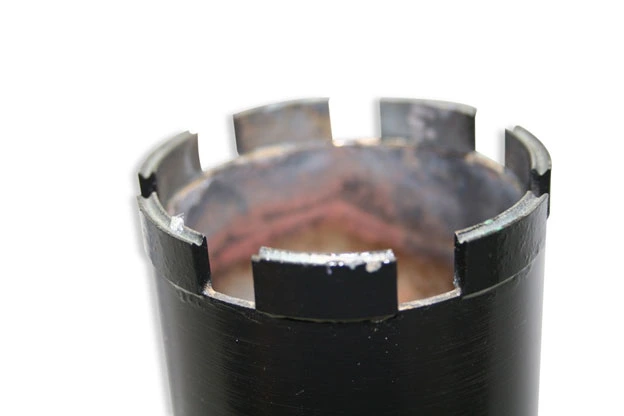
Concave or U-shaped segments
Concave or U-shaped segments are designed to remove larger volumes of material while preventing core jamming. The U-shape helps facilitate efficient debris removal, especially in larger diameter bits. This profile is particularly useful in situations where core removal is critical, as it ensures smooth operation without clogging, even during heavy-duty tasks.
Tapered or Wedge-shaped Segments
Tapered or Wedge-shaped Segments offer a balance between fast cutting and extended lifespan. The design features a sharp, narrow tip that aggressively engages the material, while the wider base aids in heat dispersion. This geometry is suitable for mid to hard materials, such as certain types of stone or harder concretes, where maintaining cutting speed without sacrificing durability is important.
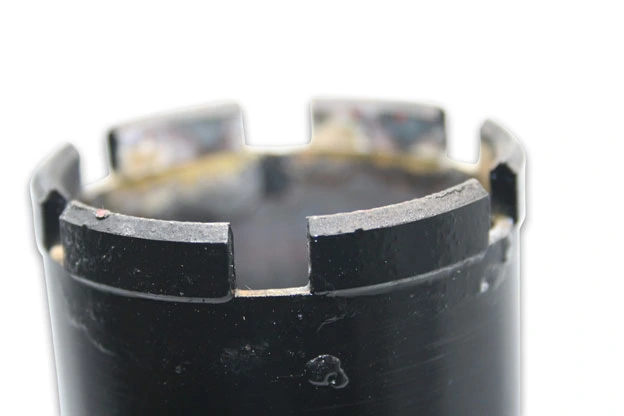
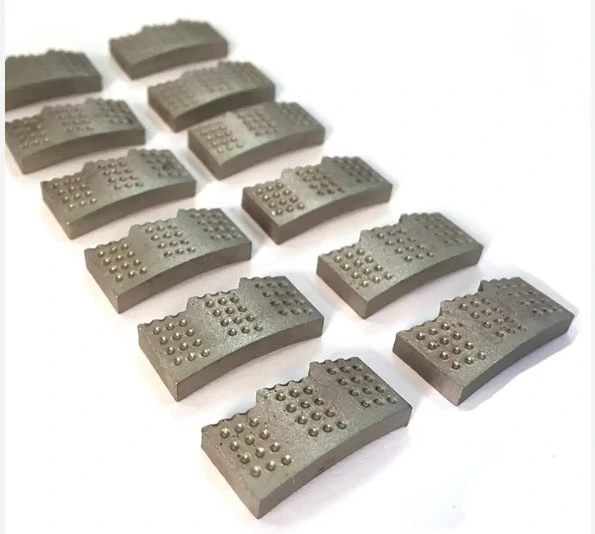
Some core bits are designed with combination or mixed profiles.
These feature segments that incorporate multiple geometries to offer the advantages of different shapes in one tool. Such designs are tailored to meet the specific challenges of complex drilling conditions, where different material types or varying performance requirements must be addressed simultaneously.
The exact radius or angle of a segment varies depending on the manufacturer’s specifications, tool design, and intended application. For instance, one manufacturer’s roof top segment may feature a steeper point than another’s, based on proprietary testing and design optimizations. The geometry of the segment influences key factors such as drilling speed, surface finish, heat generation, and the overall lifespan of the core bit.
Table comparing different segment geometries for diamond core bits based on their design, performance, and ideal applications:
|
Segment Type |
Design Characteristics |
Performance |
Best For |
Advantages |
|---|---|---|---|---|
|
Flat Segment (Rectangular or Square Profile) |
Rectangular or square cutting edge |
Consistent cutting performance for general-purpose drilling |
Concrete, masonry, and stone |
Versatile, reliable, and widely used |
|
Roof Top or Turbo Segment (Pointed Profile) |
Pointed or peak-like design |
Fast penetration, quick starting in hard materials |
Hard materials like granite and reinforced concrete |
Faster drilling speed, efficient material penetration |
|
Rounded or Convex Segment |
Curved or rounded cutting edge |
Smooth drilling with minimal chipping |
Delicate materials like marble and ceramics |
Reduces risk of chipping, provides smoother finish |
|
Concave or U-shaped Segment |
U-shaped profile |
Removes larger material volumes and prevents core jamming |
Larger diameter bits and core removal operations |
Excellent debris removal, reduces jamming |
|
Tapered or Wedge-shaped Segment |
Narrow tip with a wider base |
Aggressive cutting with heat dispersion |
Mid to hard materials like stone and harder concretes |
Fast cutting with balanced heat management |
|
Combination or Mixed Profiles |
Multiple segment profiles combined in one tool |
Adaptable performance for varying materials and conditions |
Complex drilling situations with diverse material needs |
Offers the advantages of different geometries in one bit |
Diamond Core Bit Mounting Types
The mounting type for diamond core bits is a critical factor in ensuring effective performance during concrete and construction drilling. Proper mounting not only secures the core bit to the drill but also impacts the accuracy, efficiency, and safety of the drilling process. Depending on the specific application, type of equipment, and drilling requirements, different mounting systems are used to optimize the operation.
One of the most common mounting types for diamond core bits is threaded mounting. Threaded core bits feature a threaded connection that screws onto the drill’s spindle. This secure attachment provides a stable and firm connection, which is crucial for high-power drilling tasks like cutting through concrete or reinforced concrete. Threaded mounts are commonly used for larger diameter bits and in heavy-duty applications because they can withstand the high torque generated by powerful drilling rigs. The threads may vary depending on the manufacturer or equipment, with standard options like 1-1/4" UNC (Unified National Coarse) threads being popular in many professional-grade drills used for concrete construction.
5/8"-11 female thread is primarily used for smaller diameter core bits, typically ranging from 1/4 inch to around 4 inches. This thread size is common for handheld core drills and portable drilling rigs used in lighter-duty applications. Core bits with a 5/8"-11 thread are often utilized for drilling smaller holes in concrete, masonry, and stone, such as for anchor bolts, plumbing installations, or electrical conduits. The 5/8"-11 thread is highly compatible with many handheld angle grinders and small drilling machines, making it a versatile option for contractors working on jobs that require mobility and flexibility.
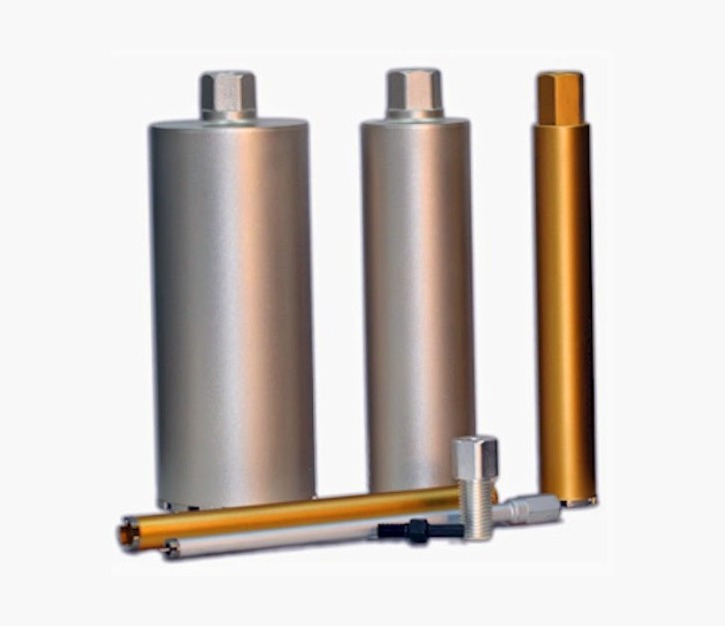
The 1-1/4"-7 female thread, on the other hand, is used for larger diameter core bits, typically starting at around 4 inches and going up to 14 inches or more. This thread size is more robust and is commonly found in larger, heavy-duty core drills and rig-mounted drilling systems designed for more demanding applications. The 1-1/4"-7 thread is well-suited for cutting larger holes in reinforced concrete, asphalt, and other dense materials, making it ideal for structural work, utility installations, and large-scale construction projects. The larger diameter core bits with this thread are often used for creating openings in walls, floors, and pavements for pipes, HVAC systems, and other large infrastructure components.
Both thread sizes provide a secure and stable attachment, which is essential for preventing vibrations, wobbling, and misalignment during drilling. A strong connection ensures that the core bit remains properly aligned, reducing wear and tear on both the bit and the drilling equipment, while also delivering more precise cuts.
In terms of performance, the 5/8"-11 and 1-1/4"-7 threads are designed to handle different levels of torque and power. The 5/8"-11 thread is suitable for lower torque applications where portability and ease of use are important, while the 1-1/4"-7 thread is built to withstand the higher torque generated by larger drilling machines. This makes the 1-1/4"-7 thread ideal for heavy-duty drilling in concrete slabs, walls, and other large structures.
Compatibility is another factor to consider when selecting a core bit with either of these thread sizes. Most handheld core drills and smaller rig-mounted systems will be compatible with 5/8"-11 threads, while larger, more powerful rigs typically use the 1-1/4"-7 thread. It's important to ensure that the core bit and the drill rig have matching thread sizes to avoid improper fitment, which can lead to equipment damage or unsafe operation.
Additionally, the longevity of the core bit is influenced by the thread size. Larger core bits with 1-1/4"-7 threads often have thicker diamond segments and are designed for longer wear in high-stress environments, while smaller bits with 5/8"-11 threads are typically used for shorter drilling projects or for materials that do not require as much force.
Quick-release mounts, also known as quick-change mounts, are another option for diamond core bits. These mounts allow the bit to be changed quickly and easily without the need for additional tools. Quick-release systems are designed to save time during operations, particularly in projects where different core bit sizes are required. In fast-paced construction environments, this system can be advantageous, reducing downtime and increasing overall productivity. While they are not as common as threaded mounts for large-diameter bits, they are popular for smaller core bits and less intensive applications where speed and flexibility are prioritized.
Spline or SDS (Slotted Drive System) mount
which is typically used for handheld drills and rotary hammers. Spline and SDS mounting systems are often found in smaller diameter diamond core bits, particularly for handheld drilling into concrete, masonry, and stone. These systems provide a secure and stable connection, designed to withstand the high impacts of rotary hammers while maintaining precision. SDS mounts are easy to install and remove, making them user-friendly and versatile in a variety of construction tasks, such as creating holes for anchors or pipes.
Bayonet-style mounts are also used in some specialized diamond core drilling systems. This type of mounting involves twisting the bit into place, locking it securely onto the drill. Similar to quick-release systems, bayonet mounts enable fast bit changes and are valued in situations where efficiency is key. While not as widely used as threaded mounts, they provide a secure fit and are favored in projects requiring frequent core bit swaps.
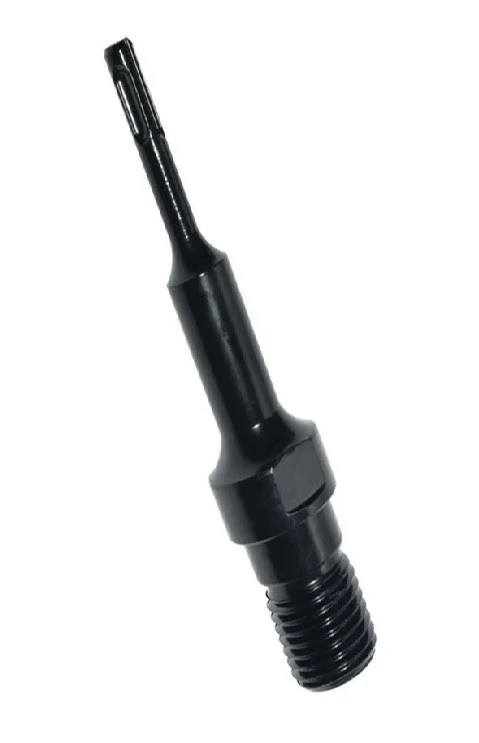
The choice of mounting type affects more than just the attachment process; it also influences the precision and stability of the drilling operation. A secure mounting system minimizes vibrations and wobbling during drilling, ensuring that the bit remains aligned and that the holes are drilled with accuracy. Poor or loose mounting, on the other hand, can lead to misalignment, uneven cuts, and even damage to the bit or equipment.
Additionally, the type of drill used often dictates the mounting type. Handheld core drills, which are typically used for smaller, more portable jobs like drilling through walls or for creating openings in confined spaces, usually feature SDS or spline mounts. These mounting systems are designed to be easy to handle and suitable for portable equipment. In contrast, larger rig-mounted core drills, which are used for more demanding tasks such as drilling through concrete slabs or foundations, often require threaded mounts due to the higher torque and power involved.
Table comparing different diamond core bit mounting types based on the provided information:
|
Mounting Type |
Description |
Best Applications |
Advantages |
Limitations |
|---|---|---|---|---|
|
5/8"-11 Female Thread |
A smaller threaded connection used for core bits typically ranging from 1/4" to 4". Commonly found in handheld drills and portable rigs for light-duty tasks. |
Best for smaller holes in concrete, masonry, stone; ideal for anchor bolts, plumbing, or electrical conduits. |
Versatile and compatible with many handheld drills and grinders. Offers portability and ease of use. |
Limited to smaller diameter core bits, not suitable for heavy-duty or large-scale drilling projects. |
|
1-1/4"-7 Female Thread |
A larger, more robust threaded connection used for core bits 4" and larger. Designed for heavy-duty drilling in large concrete slabs or reinforced materials. |
Best for large-diameter holes in reinforced concrete, asphalt, and dense materials in structural projects. |
Can handle high torque, suitable for large-diameter drilling, and offers durability in tough applications. |
Requires larger, more powerful drilling rigs. Not compatible with smaller or portable equipment. |
|
Quick-release Mounts |
A mounting system that allows for fast, tool-less bit changes, increasing efficiency in fast-paced construction environments. |
Best for small-to-medium tasks requiring frequent core bit size changes, where flexibility and speed are key. |
Saves time by allowing quick bit changes without additional tools. Improves productivity in dynamic environments. |
Not commonly used for larger core bits or heavy-duty tasks. Limited to lighter or less intensive applications. |
|
Spline or SDS Mounts |
Slotted drive systems used in handheld rotary hammers and smaller diameter core bits. Common for handheld drilling into concrete and masonry. |
Best for smaller core bits in handheld drilling tasks, such as creating holes for anchors, pipes, or fixtures. |
Easy to install and remove. Provides stability and precision, designed for handheld or smaller drilling systems. |
Limited to smaller diameter bits. Less suitable for high-torque, heavy-duty drilling operations. |
|
Bayonet-style Mounts |
A twist-and-lock system where the core bit is secured by rotating it into place. Used in specialized diamond drilling systems requiring fast bit changes. |
Ideal for situations requiring frequent core bit swaps where speed and efficiency are critical. |
Allows for fast bit changes similar to quick-release systems. Provides a secure and reliable fit. |
Less commonly used in mainstream construction drilling. Not as robust as threaded mounts for heavy-duty tasks. |
Diamond Core Bit Body (Steel Tube Specifications)
One important aspect of these tools is the steel tube type, configuration, and specifications, which play a crucial role in the bit's performance, durability, and suitability for various drilling tasks. The steel tube, which serves as the core bit’s body, provides structural support and facilitates efficient material removal during the drilling process.
Steel Tube Type and Material Composition
The steel tube of a diamond core bit is typically made from high-strength alloy or hardened steel to withstand the rigors of cutting through dense and abrasive materials. This tube is responsible for maintaining the stability and alignment of the bit during drilling, ensuring that the diamonds in the cutting segments remain in optimal contact with the material being drilled. The steel tube must be robust enough to resist bending, warping, or cracking under high-torque conditions, especially when working with reinforced concrete or encountering embedded materials like rebar.
The thickness of the steel tube can vary depending on the bit’s intended use. For standard concrete drilling, thinner-walled steel tubes are sufficient for providing durability without adding unnecessary weight to the bit. Thicker steel tubes are typically used in heavy-duty applications where greater strength and stability are required, such as when drilling larger diameter holes or in particularly challenging materials.
Configuration of the Steel Tube
The configuration of the steel tube is designed to support the specific demands of the drilling task. Most diamond core bits feature a hollow cylindrical steel tube, allowing for efficient removal of the core material from the hole being drilled. The hollow design is essential for core extraction, as it enables debris to move away from the cutting area, preventing clogging and maintaining consistent drilling speed and precision.
The length of the steel tube is also an important specification. Diamond core bits are available in various lengths, depending on the depth of the hole required. For shallow drilling tasks, shorter core bits are sufficient, while deeper drilling requires longer tubes. Standard lengths range from 4 inches to over 24 inches, with custom lengths available for specialized applications. Longer tubes are often needed for construction tasks like creating openings for large-diameter pipes, utilities, or infrastructure components in walls, floors, or pavements.
Another key feature of the steel tube’s configuration is its flange design. The flange, typically located at the base of the tube where it connects to the drill’s spindle, plays a critical role in securing the bit to the drill. Flanges must be precisely machined to ensure a snug, stable connection that minimizes vibration and misalignment during drilling. In some cases, special flanges are designed to reinforce the connection between the bit and the drilling machine, especially for large-diameter core bits.
Ventilation and Cooling Configurations
Efficient cooling is crucial during concrete and construction drilling, as the high friction between the diamond segments and the material generates significant heat. Many steel tubes for diamond core bits feature ventilation holes or slots along the tube’s body. These openings allow water or air to circulate through the bit, cooling the cutting edge and flushing away debris. For wet drilling, water is typically used as a coolant, preventing overheating and helping to prolong the life of the bit. In dry drilling applications, air circulation may be utilized to dissipate heat.
The size and placement of these ventilation holes are designed to optimize the cooling process while maintaining the structural integrity of the steel tube. The number and pattern of slots can vary depending on the bit’s diameter and the type of material being drilled. For example, bits used for drilling reinforced concrete with embedded rebar often require larger or more frequent cooling slots to handle the increased heat generated by cutting through both concrete and steel.
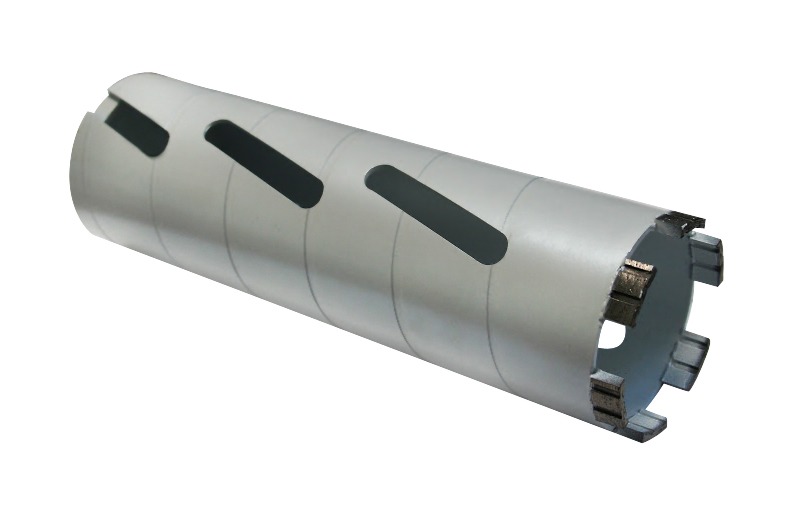
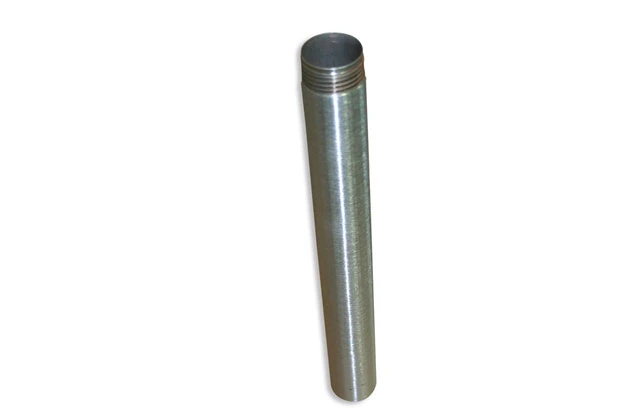
Tube Diameter and Wall Thickness
The diameter of the steel tube corresponds to the size of the hole being drilled. Standard diameters for diamond core bits range from small sizes like 1/4 inch to large sizes over 14 inches, depending on the application. Small-diameter core bits are often used for tasks like drilling holes for anchors or conduit installations, while larger-diameter bits are used for creating openings in walls, floors, or roads for utility lines, pipes, or structural reinforcements.
The wall thickness of the steel tube is another important specification that affects the bit’s performance. Thicker walls provide more strength and durability, making them suitable for heavy-duty applications, while thinner walls reduce the bit’s weight and allow for faster drilling in less demanding environments. The balance between tube strength and weight is essential for maintaining optimal drilling performance and extending the life of the bit.
Diamond Core Bit Diamond Grit Sizes

Diamond grit size is a critical factor in the performance of diamond core bits used in concrete and construction applications. The grit size refers to the size of the diamond particles embedded in the segments of the core bit, and it directly affects the cutting speed, precision, and overall efficiency of the drilling process. Selecting the right diamond grit size depends on the material being drilled, the desired finish, and the specific requirements of the application.
Understanding Diamond Grit Size

Diamond grit is measured by the number of particles per mesh size, with larger numbers indicating smaller particles and smaller numbers indicating larger particles. For example, a grit size of 40/50 means that the diamond particles are relatively coarse, while a grit size of 100/120 indicates finer particles. The size of the diamond grit determines how aggressively the core bit cuts through the material, as well as the smoothness of the drilled hole.
In concrete and construction applications, the choice of diamond grit size plays a significant role in balancing cutting speed, bit lifespan, and the quality of the drilled hole. Coarser grits tend to cut more quickly but may leave a rougher surface, while finer grits offer smoother finishes but may drill at a slower rate.
Coarse Grit Sizes (30/40, 40/50)
Coarse diamond grit sizes, such as 30/40 or 40/50, are typically used for aggressive cutting in hard materials like reinforced concrete, stone, and asphalt. These larger diamond particles are more durable and can withstand the high abrasion and resistance encountered when drilling through dense materials or embedded steel rebar. Coarse grit is ideal for applications where speed and efficiency are more important than a smooth finish.
For example, when drilling large holes in reinforced concrete for utility installations, plumbing, or structural openings, coarse grit sizes allow for faster penetration through the concrete and any rebar within it. The large diamond particles provide excellent durability, making these bits suitable for heavy-duty construction projects that require high productivity.
However, while coarse grit sizes offer faster cutting, they may produce a rougher edge on the drilled hole, which is acceptable in most construction tasks but may not be ideal for applications where precision and smoothness are required.
Medium Grit Sizes (50/60, 60/80)
Medium diamond grit sizes, such as 50/60 or 60/80, strike a balance between cutting speed and surface finish. These grit sizes are commonly used for general-purpose drilling in a variety of materials, including concrete, brick, and masonry. Medium grit core bits are versatile, providing reasonable cutting speed while also delivering a smoother finish compared to coarse grit.
For most construction applications, medium grit sizes offer the best compromise between efficiency and quality. They are suitable for tasks like drilling holes for anchor bolts, electrical conduit, or HVAC systems, where both speed and accuracy are important. Medium grit bits are durable enough to handle light to medium-duty drilling and can cut through reinforced concrete, though they may not be as fast as coarse grit bits in heavy-duty applications.
Additionally, medium grit sizes are often used in projects where the drilled hole will be visible or require a cleaner finish, such as in exposed concrete surfaces or architectural elements.
Fine Grit Sizes (80/100, 100/120)
Fine diamond grit sizes, such as 80/100 or 100/120, are used in applications that require a high level of precision and a smooth finish. These smaller diamond particles are ideal for softer materials or situations where minimal chipping or damage to the material is crucial. Fine grit is typically used for finishing work, delicate surfaces, or drilling in materials like tiles, ceramics, and decorative stones.
In concrete applications, fine grit sizes are less commonly used, as they tend to cut more slowly and wear out faster than coarser grits. However, they are valuable in specific situations where accuracy and finish quality are prioritized over speed. For example, when drilling small holes in concrete for precise fittings or fixtures, fine grit core bits can provide the level of precision needed without causing excessive damage to the surrounding material.
Fine grit sizes are also preferred for tasks where the final appearance of the drilled hole is important, such as in decorative concrete elements or architectural features. The smooth finish produced by fine grit core bits can reduce the need for additional smoothing or polishing after the hole is drilled.
Grit Size Selection Based on Application
The selection of diamond grit size depends on the specific needs of the project. For heavy-duty construction tasks where speed and efficiency are paramount, coarse grit sizes are generally the best option. They provide the aggressive cutting power needed to penetrate hard materials quickly, especially in reinforced concrete where resistance from rebar can slow down the drilling process.
For more general-purpose drilling or applications that require a balance between speed and finish quality, medium grit sizes are typically the preferred choice. These bits can handle a wide range of materials and deliver satisfactory performance in most construction tasks, making them versatile and cost-effective.
When precision and smoothness are critical, fine grit sizes are the go-to option. Though slower, these bits offer the highest level of accuracy and surface quality, making them suitable for specialized applications where the appearance and integrity of the drilled hole are key concerns.
Table summarizing the diamond grit sizes for different concrete and construction applications:
|
Grit Size |
Applications |
Material Type |
Advantages |
Limitations |
|---|---|---|---|---|
|
Coarse (30/40, 40/50) |
Heavy-duty tasks such as utility installations, plumbing, large structural openings |
Reinforced concrete, hard stone, asphalt |
Fast cutting speed, durable in abrasive conditions, handles rebar well |
Rougher surface finish, less precision |
|
Medium (50/60, 60/80) |
General-purpose drilling for anchor bolts, HVAC, electrical conduits |
Concrete, brick, masonry |
Good balance of speed and smoothness, versatile for a variety of materials |
Slower than coarse grit for very hard or reinforced materials |
|
Fine (80/100, 100/120) |
Precision drilling where smooth finish and minimal damage are critical |
Softer materials like tiles, ceramics, decorative stone |
High accuracy, smooth finish, minimal chipping or damage |
Slower cutting speed, wears out faster in harder materials |
Diamond Core Bit Diamond Concentration
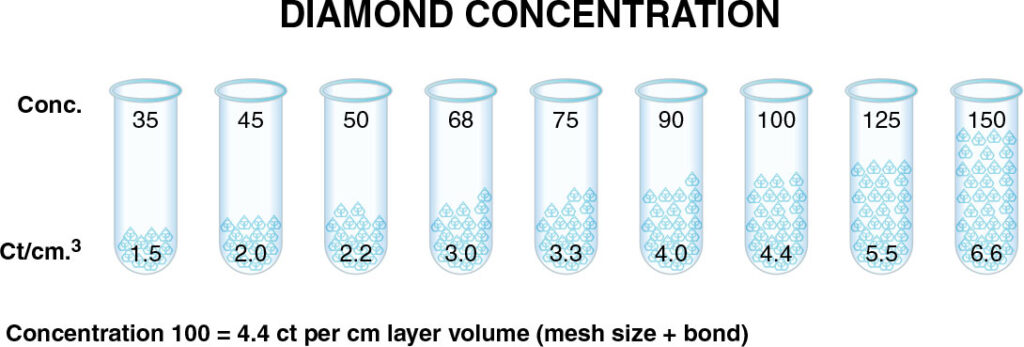
Diamond concentration is a key factor that influences the performance of diamond core bits, especially in concrete and construction applications. The term "diamond concentration" refers to the amount or density of diamond particles embedded within the matrix of the bit’s cutting segments. This concentration is typically expressed as a percentage or number (such as 50, 75, or 100), with higher numbers indicating a greater amount of diamonds within the segment. Diamond concentration has a direct impact on cutting speed, durability, bit lifespan, and overall efficiency when drilling through tough materials like concrete, masonry, and reinforced concrete.
Importance of Diamond Concentration
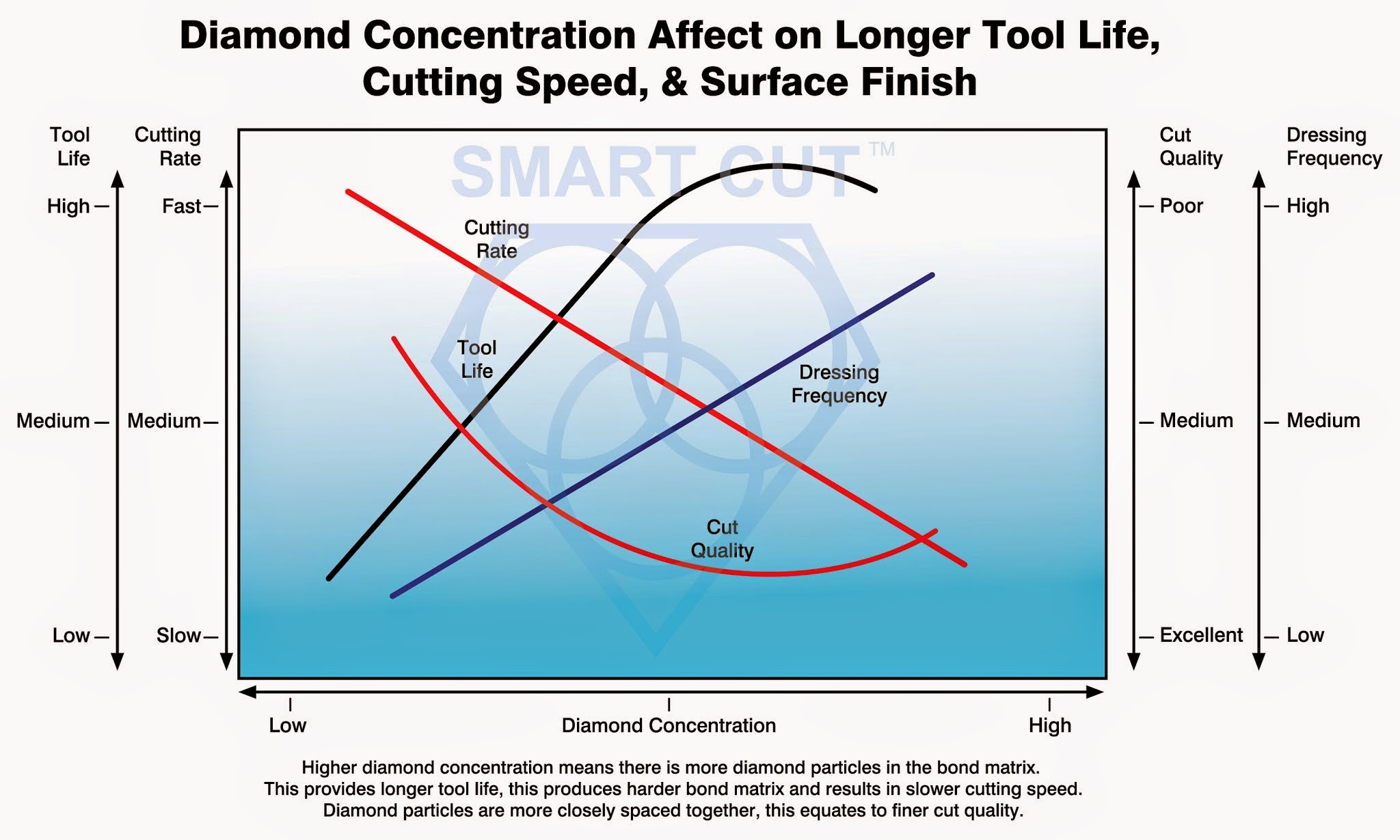
Diamond concentration is crucial because diamonds are the hardest known material, and they provide the cutting power necessary to penetrate dense and abrasive materials. The more diamonds present in the core bit's segments, the more cutting edges are available to interact with the material, which in turn enhances the bit's ability to cut efficiently and last longer. However, the right balance between diamond concentration and other factors such as grit size, matrix composition, and application requirements is essential for optimizing the performance of the core bit.
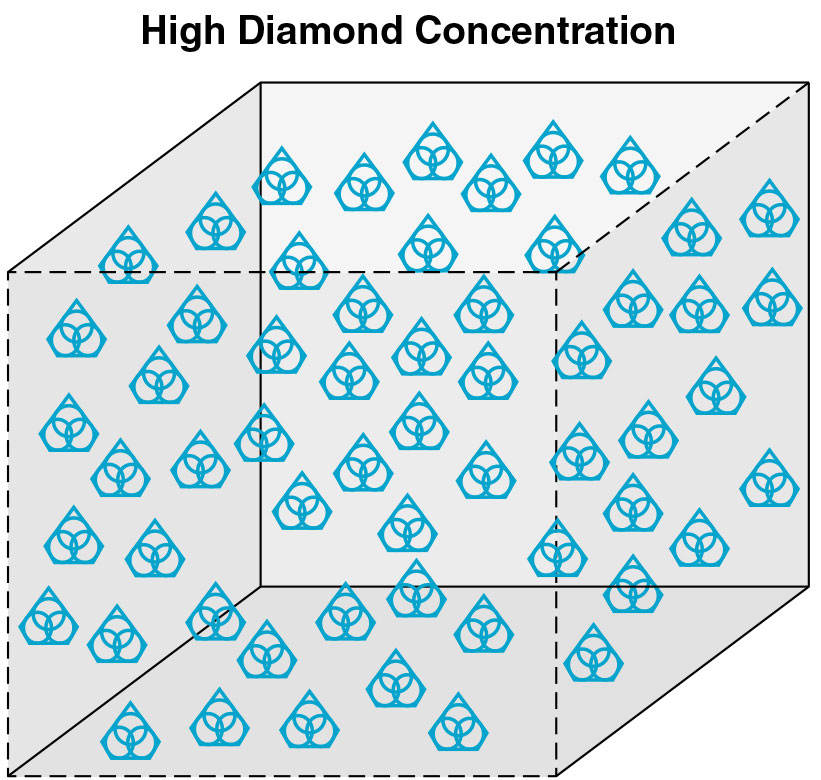

High Diamond Concentration (75-100)
Diamond core bits with a high concentration of diamonds (75 to 100) are designed for heavy-duty drilling applications where high durability and long life are critical. These bits have a higher density of diamonds in the cutting segments, which means there are more cutting edges available to engage with the material during drilling. This increased number of diamonds allows the bit to maintain a steady cutting rate and resist wear, even when used in hard, abrasive materials such as reinforced concrete or natural stone.
High diamond concentration is typically used in applications where the bit will be subjected to prolonged use or harsh conditions. For example, in large-scale construction projects where the core bit must drill through reinforced concrete containing steel rebar, a higher diamond concentration is necessary to withstand the constant abrasion and heat generated by the drilling process. Additionally, the higher diamond content ensures that the bit can cut through both the concrete and the embedded steel efficiently without wearing down too quickly.
However, the trade-off with high diamond concentration is that these bits may cut at a slower rate compared to those with lower concentrations, especially in softer materials. The increased number of cutting points means more friction is generated during drilling, which can reduce cutting speed. Despite this, the increased lifespan of the bit in challenging conditions often makes high diamond concentration the most cost-effective choice for heavy-duty applications where frequent bit changes would lead to downtime and increased operational costs.
Medium Diamond Concentration (50-75)
Bits with medium diamond concentration (50 to 75) offer a balance between cutting speed and durability. These bits are suitable for general-purpose drilling tasks in a variety of materials, including concrete, masonry, and brick. The moderate amount of diamonds in the segments provides a good level of durability while still allowing for relatively fast cutting speeds.
Medium concentration core bits are often used in situations where the drilling job requires a combination of efficiency and longevity. For example, they are commonly used for drilling medium-sized holes in concrete for anchor bolts, pipes, or utility installations. They provide a good balance of wear resistance and cutting efficiency, making them a versatile option for construction professionals who need to drill through multiple types of materials without having to switch out the bit frequently.
Medium diamond concentration also offers more flexibility in terms of cutting speed. Since there are fewer diamonds in the matrix compared to high-concentration bits, less friction is generated, which allows for faster cutting in softer materials. However, these bits may wear out faster when used on highly abrasive or reinforced materials, so they are best suited for tasks that involve moderate to hard materials but do not involve heavy rebar or extremely tough substrates.
Low Diamond Concentration (25-50)
Low diamond concentration core bits (25 to 50) are typically used for softer materials and less demanding applications. These bits have fewer diamonds in the segments, which results in faster cutting speeds because there is less friction between the bit and the material. However, because of the lower number of diamonds, these bits tend to wear out more quickly, particularly when used on hard or abrasive materials like concrete with embedded steel.
Low concentration bits are best suited for applications where speed is more important than longevity. For instance, when drilling through softer, non-reinforced concrete, brick, or asphalt, a low-concentration bit can offer fast drilling speeds and is ideal for short-term projects or situations where frequent bit changes are acceptable. Contractors may opt for low diamond concentration bits when working on projects with softer materials or when precise finishes and long tool life are not the primary concerns.
One of the benefits of low diamond concentration is that the reduced number of diamonds allows the matrix to wear down faster, which in turn exposes fresh, sharp diamonds more quickly. This keeps the bit cutting aggressively throughout the drilling process, making it effective for quick tasks that require fast material removal. However, the trade-off is a shorter overall lifespan, making low concentration bits less suitable for large-scale or long-duration projects.
Diamond Concentration and Matrix Bond
The matrix bond of the core bit, whether soft or hard, works in conjunction with diamond concentration to determine overall performance. For example, a soft bond matrix is designed to wear away quickly to expose fresh diamonds, which can be beneficial in harder materials. High diamond concentration bits are often paired with harder matrix bonds to ensure that the diamonds are exposed at a steady rate, maintaining cutting performance over time. On the other hand, low concentration bits may be paired with softer bonds to encourage fast material removal in softer substrates.
Choosing the Right Diamond Concentration
The choice of diamond concentration depends on the specific requirements of the project. For heavy-duty tasks involving reinforced concrete, high diamond concentration is preferred because it provides the durability needed to cut through both concrete and rebar without excessive wear. For general construction tasks that involve a mix of materials, medium concentration bits offer a good balance of speed and lifespan. In less demanding applications, such as drilling in soft materials or for short-term projects, low concentration bits provide fast cutting speeds at the cost of shorter tool life.
Table summarizing diamond core bit concentration levels for different concrete and construction applications:
|
Diamond Concentration |
Applications |
Material Type |
Advantages |
Limitations |
|---|---|---|---|---|
|
High (85-100) |
Reinforced concrete, granite, hard stone |
Very hard materials with steel rebar |
Long lifespan, high durability, can cut through tough materials including rebar |
Slower cutting speed due to high friction |
|
Medium (50-75) |
General-purpose: concrete, masonry, asphalt |
Standard concrete, brick, cinder block, masonry |
Good balance between speed and durability, versatile for most construction tasks |
Wears faster in harder or abrasive materials |
|
Low (25-50) |
Soft concrete, soft brick, asphalt |
Softer or less abrasive materials |
Fast cutting speed, cost-effective for softer materials |
Shorter lifespan, wears out quickly in tough conditions |
Diamond Core Bit Bond Matrix Composition

Diamond core bits used in concrete and construction applications rely heavily on the bond composition to determine their performance, durability, and efficiency. The bond, which holds the diamond particles in place within the cutting segments, wears away during drilling, allowing new diamonds to be exposed to maintain the bit’s cutting efficiency. The bond composition plays a critical role in this process and is specifically chosen to suit various drilling tasks based on the material being drilled, the level of abrasion, and whether wet or dry drilling is being used.
Metal bonds are the most common for diamond core bits in construction applications. The matrix holding the diamonds is often composed of materials like bronze, cobalt, nickel, and sometimes iron or tungsten carbide. Each of these materials imparts specific qualities to the bit, affecting its wear rate, cutting speed, and resistance to heat and abrasion.
bronze matrix
is a copper-based alloy widely used in diamond core bits. It is particularly suitable for softer to medium-hard materials, such as non-reinforced concrete, brick, and asphalt. The alloy’s ability to conduct heat effectively helps dissipate the high temperatures generated during drilling, making it useful for wet drilling applications where water reduces friction and helps extend the bit's life. A bronze bond strikes a balance between cutting speed and wear resistance, ideal for less abrasive materials that do not require the extra toughness of more durable alloys.


Cobalt-based alloys
are commonly used for more demanding tasks, such as drilling in reinforced concrete, granite, and other hard, abrasive materials. Cobalt provides high wear resistance and can withstand the high temperatures generated in dry drilling applications. This composition makes cobalt bonds durable and long-lasting, even in tough environments where both concrete and steel rebar are present. While cobalt bonds wear more slowly than bronze, they are well-suited for situations where bit longevity is crucial.
Nickel-based bonds, though less common than bronze or cobalt, are also used in diamond core bits for their toughness and heat resistance. They are often found in precision tools or applications where the drilling material is particularly hard, such as granite or reinforced concrete. The nickel matrix holds the diamond particles firmly in place, even under high levels of stress, making it ideal for demanding drilling tasks.
Iron and tungsten carbide
May be added to the bond composition in certain specialty bits designed for extreme drilling conditions. These materials increase the overall hardness of the bit, allowing it to handle very tough and abrasive conditions, such as drilling through dense concrete with embedded rebar or in hard rock formations.
Selecting the appropriate bond composition is essential for optimizing performance. For softer materials like brick, asphalt, or non-reinforced concrete, a bronze bond offers the necessary wear resistance while providing fast material removal. Cobalt bonds are better suited for more abrasive materials like reinforced concrete or granite, where durability and resistance to wear are essential. In very hard materials, a nickel bond may be preferred for its toughness and ability to maintain the integrity of the diamonds during drilling.

The bond composition also impacts the choice between wet and dry drilling. In wet drilling, where water is used to cool the bit and manage heat, softer metal bonds such as bronze are commonly used. In dry drilling applications, cobalt or nickel bonds are preferred, as they can withstand the higher temperatures generated by friction.
Table comparing the different types of bond compositions for diamond core bits used in concrete and construction applications:
|
Bond Composition |
Material Type |
Performance Characteristics |
Best Applications |
Drilling Method |
|---|---|---|---|---|
|
Bronze Matrix |
Softer metals (copper-based alloy) |
Good heat dissipation, wears at a moderate rate, balances speed and durability |
Non-reinforced concrete, brick, asphalt |
Best for wet drilling |
|
Cobalt Matrix |
Cobalt-based alloy |
High wear resistance, withstands high temperatures, slow wear, durable in abrasive environments |
Reinforced concrete, granite, hard stone |
Suitable for dry or wet |
|
Nickel Matrix |
Nickel-based alloy |
Very tough, excellent heat resistance, maintains diamond integrity under heavy loads |
Hard materials such as granite, reinforced concrete |
Ideal for dry drilling |
|
Iron/Tungsten Carbide Matrix |
Iron or tungsten carbide mixed with other metals |
Provides extreme hardness, excellent for very abrasive materials, offers long lifespan |
Extreme applications, heavily reinforced concrete |
Effective in dry drilling |
Diamond Core Bit Bond Hardness
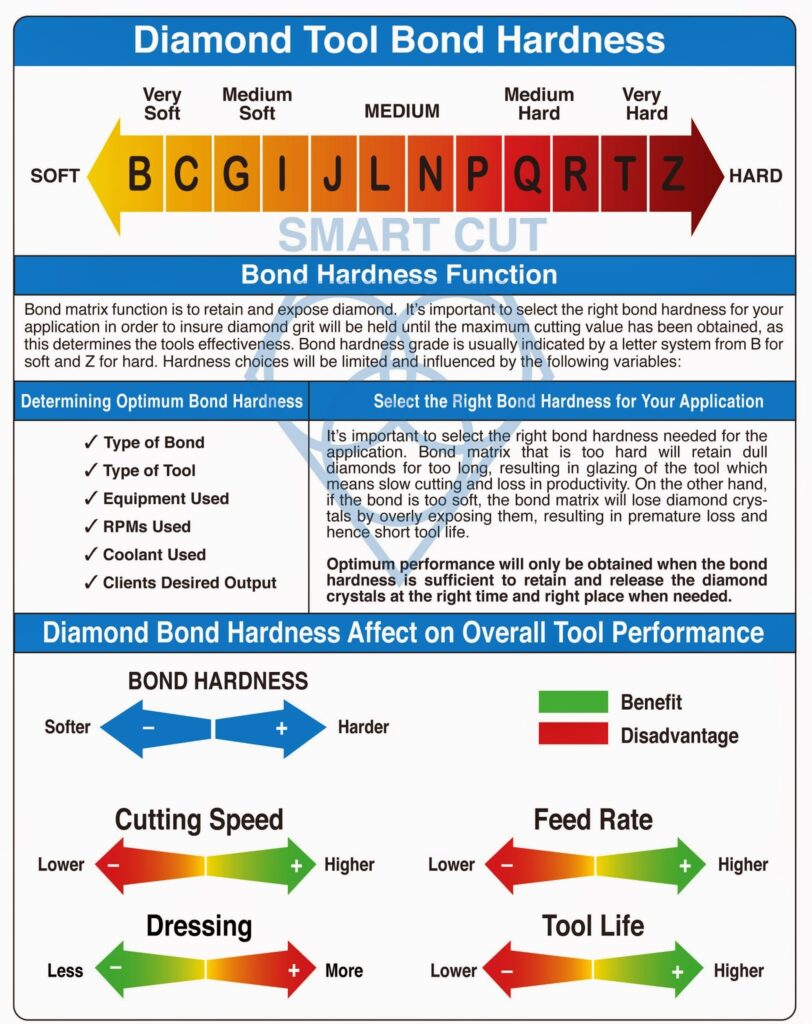
Diamond bond hardness is a critical factor in determining the performance, cutting speed, and durability of diamond core bits used in concrete and construction applications. The bond hardness refers to how easily the bond material, which holds the diamond particles in place within the cutting segments, wears down during the drilling process. As the bond wears away, new diamonds are exposed to maintain sharpness and cutting efficiency. The choice of bond hardness significantly affects how well the core bit performs in different materials, influencing both tool lifespan and overall efficiency.
Hard Bond vs. Soft Bond
The hardness of the bond used in diamond core bits generally falls into two categories: hard bonds and soft bonds. Each type of bond is designed for specific materials and conditions, and understanding when to use each type is essential for optimizing drilling performance.
A hard bond is composed of materials that wear away slowly during drilling, which means the diamonds remain exposed for a longer period. This type of bond is typically used for softer, less abrasive materials such as non-reinforced concrete, asphalt, brick, and soft stone. In these materials, a hard bond ensures that the diamonds do not wear down prematurely, thereby extending the lifespan of the bit. Since softer materials generate less abrasion on the bit, a hard bond provides the necessary strength to resist excessive wear, maintaining cutting efficiency for a longer time.
Hard bond core bits are ideal for construction tasks where the material being drilled is not too abrasive, and the focus is on achieving longer tool life. They are also suitable for wet drilling applications, where the cooling effect of water further reduces the wear rate of the bond.
However, using a hard bond on hard, abrasive materials can reduce the bit’s efficiency. In such cases, the bond may not wear down quickly enough to expose new diamonds, resulting in a dull bit that slows down cutting performance.
A soft bond, in contrast, wears away more quickly, allowing fresh diamonds to be exposed at a faster rate. This type of bond is used for drilling in harder, more abrasive materials such as reinforced concrete, granite, and other tough aggregates. These materials generate significant friction and wear on the bit, so a soft bond ensures that the core bit remains sharp by continuously exposing new layers of diamonds.
Soft bond core bits are particularly effective in heavy-duty construction projects where drilling through hard materials is common. For example, when cutting through reinforced concrete, the bit encounters both hard aggregates and steel rebar, which can dull the cutting edge quickly. A soft bond ensures that the diamonds are consistently replenished, allowing for faster and more efficient cutting.
However, soft bond core bits tend to wear out more quickly overall, especially in softer materials. This makes them less suitable for applications where tool longevity is a primary concern.
Selecting the Right Bond Hardness
Choosing the right bond hardness is essential to ensure that the diamond core bit performs optimally for the material being drilled. The key factor to consider is the hardness and abrasiveness of the material:
-
 Hard Bond for Softer Materials: A hard bond is the best choice for materials like non-reinforced concrete, asphalt, and brick, where the material does not generate much wear on the bit. The slower wear rate of a hard bond means that the diamonds are preserved for a longer time, extending the life of the core bit. Hard bonds are commonly used for wet drilling in these types of materials because the presence of water further reduces wear and prolongs the tool's lifespan.
Hard Bond for Softer Materials: A hard bond is the best choice for materials like non-reinforced concrete, asphalt, and brick, where the material does not generate much wear on the bit. The slower wear rate of a hard bond means that the diamonds are preserved for a longer time, extending the life of the core bit. Hard bonds are commonly used for wet drilling in these types of materials because the presence of water further reduces wear and prolongs the tool's lifespan.
-
 Soft Bond for Harder Materials: A soft bond is recommended for materials like reinforced concrete, granite, and other hard, abrasive substances. In these cases, the soft bond wears away quickly, ensuring that the diamonds are constantly exposed, keeping the bit sharp and maintaining high cutting speeds. This is particularly important in dry drilling, where heat and friction are greater, and the bit must stay sharp to avoid slowing down the drilling process.
Soft Bond for Harder Materials: A soft bond is recommended for materials like reinforced concrete, granite, and other hard, abrasive substances. In these cases, the soft bond wears away quickly, ensuring that the diamonds are constantly exposed, keeping the bit sharp and maintaining high cutting speeds. This is particularly important in dry drilling, where heat and friction are greater, and the bit must stay sharp to avoid slowing down the drilling process.
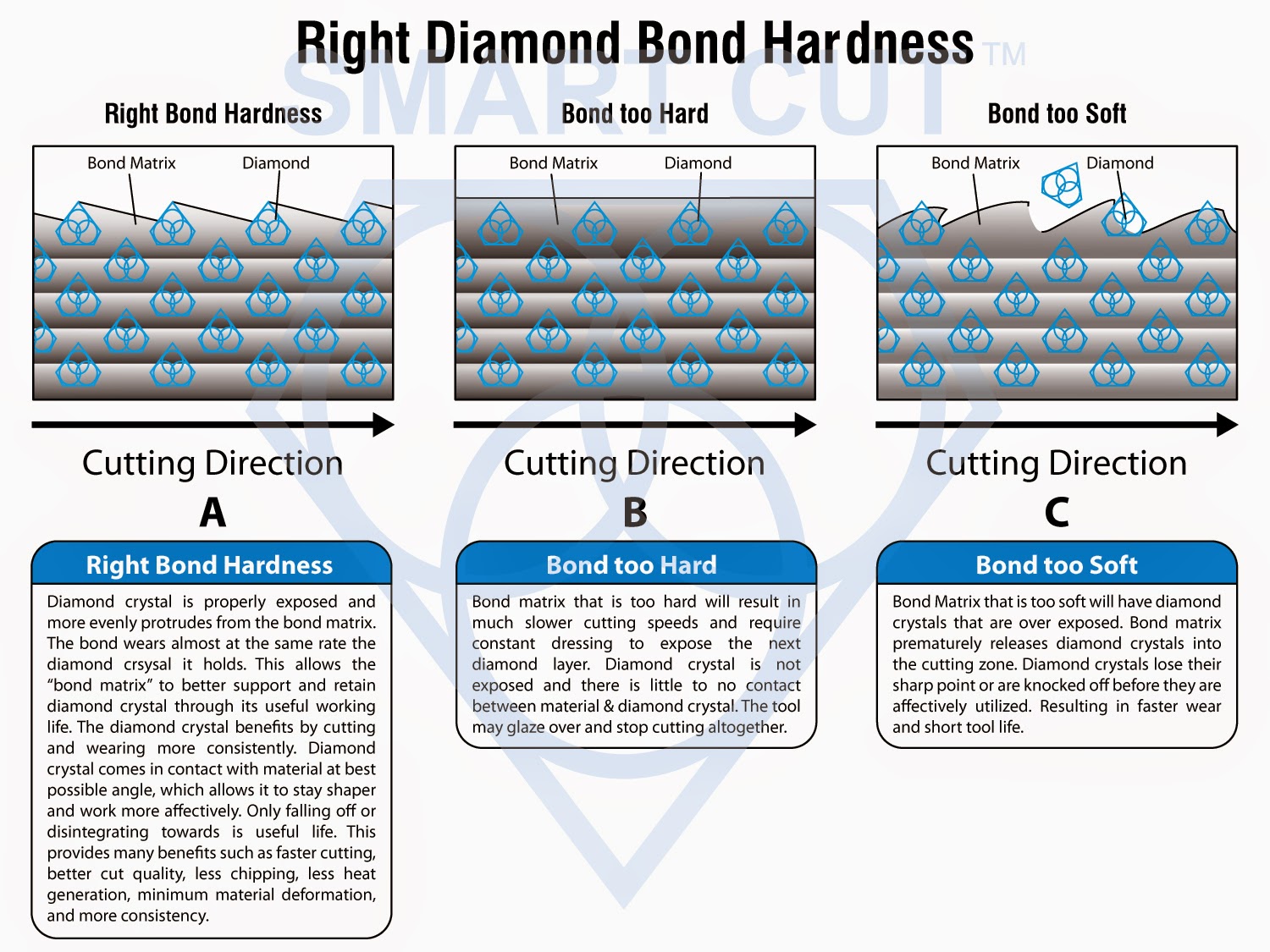
Bond Hardness and Drilling Conditions
The conditions under which the core bit is used, including whether it’s a wet or dry drilling application, also influence the choice of bond hardness. Wet drilling helps cool the bit and manage friction, which reduces wear on both the bond and the diamonds. Therefore, hard bonds are often preferred for wet drilling because they offer extended tool life without the risk of overheating.
In dry drilling, where there is no water to cool the bit, soft bonds are generally more effective. The absence of cooling increases the heat generated during drilling, and a soft bond ensures that fresh diamonds are exposed quickly enough to keep up with the increased friction. A hard bond in a dry drilling scenario may not wear away fast enough, leading to a dull bit that can overheat and slow down the drilling process.
Bond Hardness and Bit Longevity
The hardness of the bond directly impacts the longevity of the diamond core bit. A hard bond ensures a longer lifespan in softer materials because the bond wears away slowly, preserving the diamonds. However, in hard materials, a soft bond is necessary to maintain cutting efficiency, though it may lead to a shorter overall lifespan for the bit.
For contractors and construction professionals, selecting the right bond hardness is a trade-off between bit longevity and cutting speed. In softer materials, the longer lifespan provided by a hard bond helps minimize downtime and reduces the frequency of bit replacements. In contrast, for hard and abrasive materials, faster cutting speeds achieved with a soft bond outweigh the shorter tool life, as time savings during drilling are often more valuable than the cost of replacing the bit.
Table comparing hard bond and soft bond diamond core bits for concrete and construction applications:
|
Bond Type |
Best For |
Material Type |
Performance Characteristics |
Tool Longevity |
Drilling Method |
|---|---|---|---|---|---|
|
Hard Bond |
Softer, less abrasive materials |
Non-reinforced concrete, brick, asphalt |
Wears away slowly, preserves diamonds longer, maintains bit life |
Longer lifespan, slower wear |
Best for wet drilling |
|
Soft Bond |
Harder, abrasive materials |
Reinforced concrete, granite, hard stone |
Wears away quickly, exposes fresh diamonds, maintains cutting sharpness |
Shorter lifespan, faster wear in abrasive conditions |
Ideal for dry drilling |
Diamond Core Bit - Diamond Types Used
The type of diamond used in diamond core bits for concrete and construction applications is a key factor in determining the bit’s performance, cutting speed, durability, and overall efficiency. Not all diamonds are the same, and the selection of diamond type, based on size, shape, quality, and synthetic versus natural origins, plays a significant role in the success of the drilling process. Core bits use synthetic diamonds almost exclusively in construction applications due to their consistency, quality, and cost-effectiveness compared to natural diamonds.
Synthetic diamonds are manufactured in controlled environments to achieve specific qualities that make them ideal for use in diamond core bits. The ability to engineer synthetic diamonds allows manufacturers to control important factors such as size, shape, and strength, making these diamonds more suitable for construction applications than natural diamonds, which can vary in quality and are more expensive.
Monocrystalline diamonds are the most common type of synthetic diamond used in diamond core bits. These diamonds are single-crystal structures with consistent size and shape, making them highly efficient for cutting applications. Their uniformity provides predictable performance, which is essential for drilling through hard materials like concrete and granite.
Monocrystalline diamonds are known for their toughness and ability to maintain sharpness under high stress. This makes them ideal for heavy-duty construction tasks where the bit must cut through not only concrete but also embedded steel rebar. The durability of monocrystalline diamonds allows the bit to withstand the significant heat and pressure generated during the drilling process.
Diamond Quality, Shape, & Distribution in Bond Matrix

The quality of the diamonds used in the core bit also impacts its performance. Higher-quality synthetic diamonds offer greater durability, cutting precision, and heat resistance. In most construction core bits, premium-grade synthetic diamonds are used to ensure long tool life and consistent performance in challenging conditions.
Diamond Shape
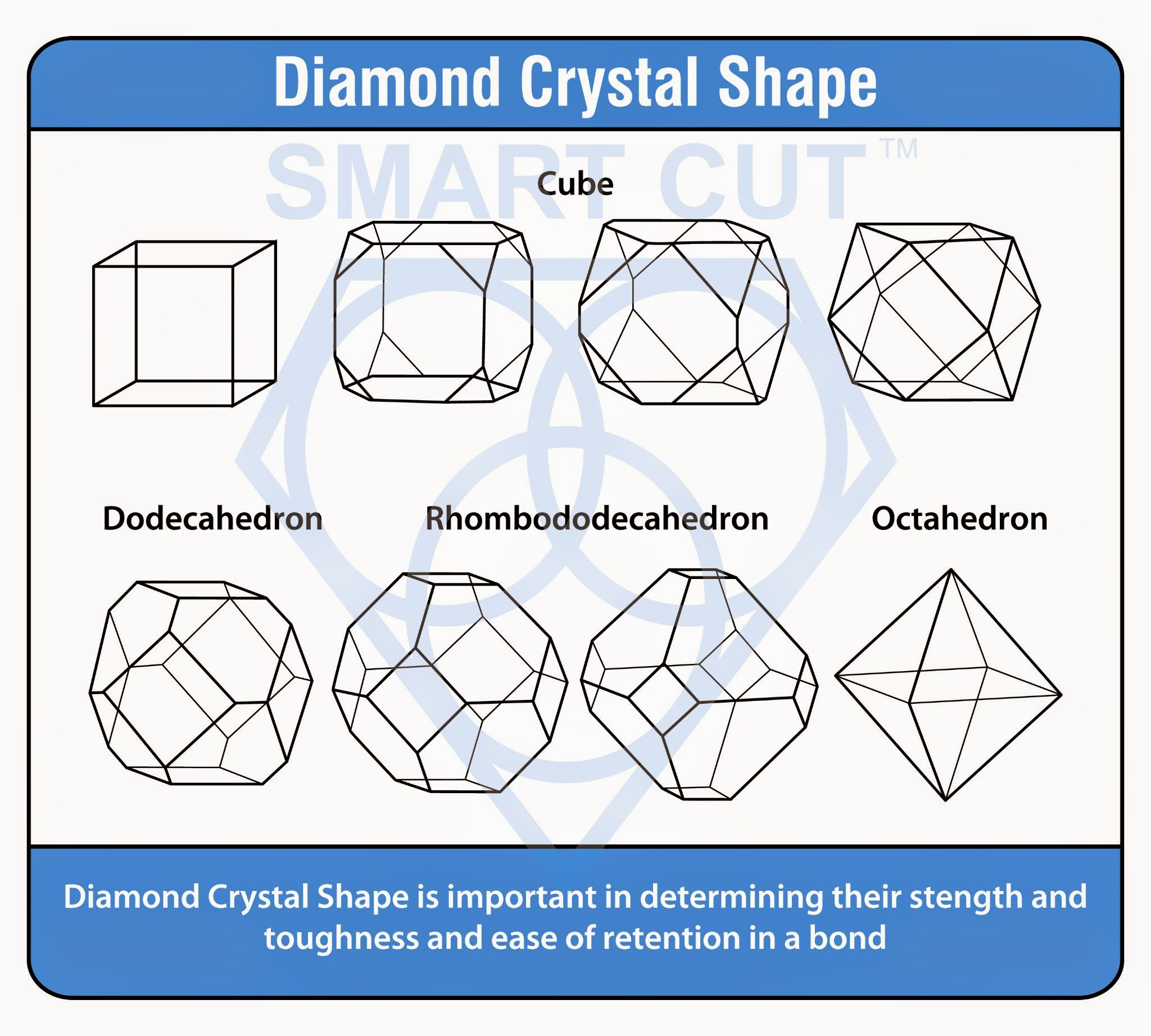
The shape of the diamond particles also plays a role in the bit’s cutting efficiency and wear characteristics. Diamonds used in core bits are typically shaped to enhance cutting performance. Sharp, angular diamonds provide aggressive cutting edges that can penetrate hard materials quickly, making them suitable for drilling through reinforced concrete and other tough materials. More rounded or cubical diamond shapes, on the other hand, offer better wear resistance and are often used in applications where longer tool life is required.
Diamond Distribution
The diamonds must be evenly distributed throughout the segment to ensure consistent cutting performance across the entire surface of the bit. Uneven diamond distribution can lead to premature wear or uneven cutting, reducing the bit’s efficiency and lifespan.
Synthetic vs. Natural Diamonds
While natural diamonds were historically used in diamond core bits, synthetic diamonds have become the industry standard due to their consistent quality, availability, and cost-effectiveness. Natural diamonds can vary in size, shape, and quality, which can result in unpredictable performance. They are also much more expensive, making them impractical for most construction and concrete drilling applications.
Synthetic diamonds, on the other hand, are produced with precise control over their properties, ensuring that they perform consistently in high-stress conditions. They can be engineered to meet the specific demands of different drilling tasks, from fast material removal in softer materials to precision cutting in hard and abrasive materials. This reliability makes synthetic diamonds the preferred choice in construction applications, where efficiency and cost control are essential.
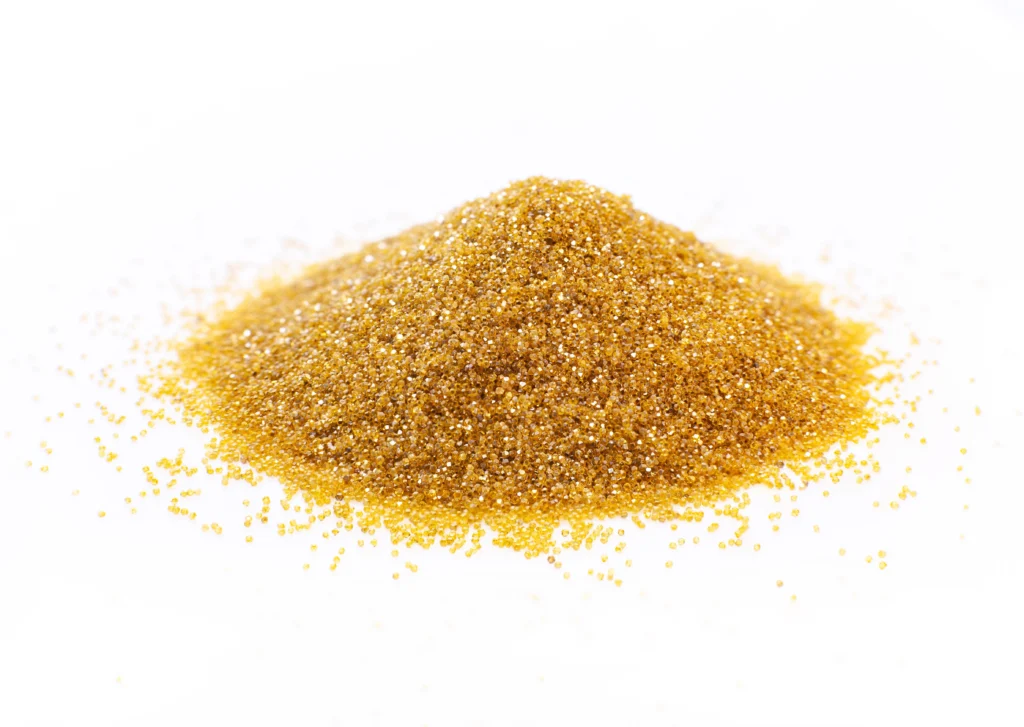
Diamond Core Bit Drilling Equipment Used
The effectiveness of these bits depends not only on their quality but also on the drilling equipment used. Different types of equipment are employed based on the drilling requirements, such as hole size, depth, material type, and jobsite conditions. Choosing the right drilling equipment ensures precision, speed, and safety in construction projects.
Handheld Core Drills
Handheld core drills are portable and versatile tools, typically used for smaller diameter holes in concrete and masonry. These lightweight, maneuverable drills are ideal for applications where mobility is essential, such as drilling through walls, ceilings, or confined spaces. Handheld core drills are powered by either electricity or battery, making them convenient for on-site tasks that require flexibility and ease of use.
Handheld core drills are best suited for drilling holes up to about 4 inches in diameter. These drills are often used in applications such as installing anchor bolts, plumbing lines, and electrical conduits. For reinforced concrete, special diamond core bits are needed, along with sufficient power to cut through embedded rebar.
Most handheld core drills feature wet or dry drilling options. Wet drilling uses water to cool the bit and reduce dust, while dry drilling uses built-in dust extraction systems to keep the work area clean. Wet drilling is typically preferred for longer drilling sessions or when cutting through dense, reinforced materials, as it helps to extend the life of the bit by reducing heat.
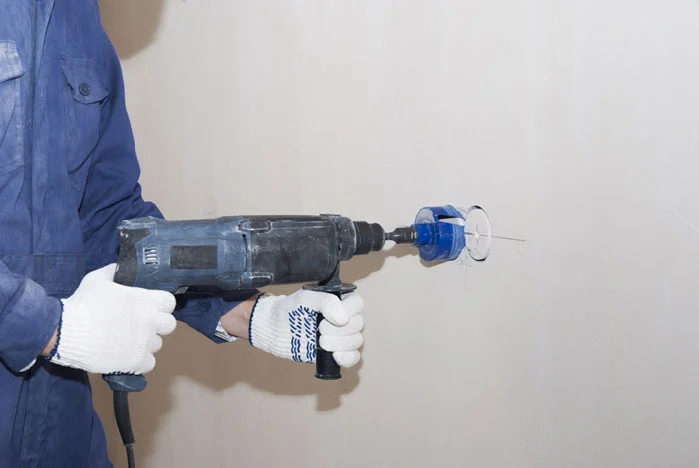

Rig-Mounted Core Drills
For more demanding applications, rig-mounted core drills are used. These machines are typically used for drilling larger diameter holes in concrete, reinforced concrete, and other hard materials. Rig-mounted drills are more powerful than handheld units and are used for projects requiring larger holes or deep core drilling. Commonly powered by electric motors, pneumatic systems, or hydraulic power, these rigs offer the torque and stability needed to drill large-diameter holes efficiently and precisely.
Rig-mounted core drills are typically used for holes exceeding 4 inches in diameter, making them ideal for applications like utility installations, creating openings in walls or floors for HVAC systems, or drilling structural holes in concrete slabs or beams. Some larger rigs are used for drilling diameters as wide as 24 inches or more, depending on the application.
Rig-mounted core drills often use track-mounted or column-mounted systems, which provide stability and precision, allowing the operator to accurately control the drilling direction and depth. This is particularly important for deep drilling in hard materials, where precision is essential to avoid damaging the material or surrounding structures.
Electric Core Drills
Electric core drills are widely used in both handheld and rig-mounted applications. Electric-powered drills are versatile and easy to operate, making them the go-to choice for most construction sites. They provide consistent power and torque, essential for drilling through concrete, masonry, and reinforced materials.
Electric drills are available in various power ratings, from light-duty models for small holes in masonry to heavy-duty models designed for deep drilling in reinforced concrete. Some electric core drills feature variable speed controls, allowing the operator to adjust the drilling speed based on the material being cut. This helps optimize the performance of the diamond core bit and prevents unnecessary wear.
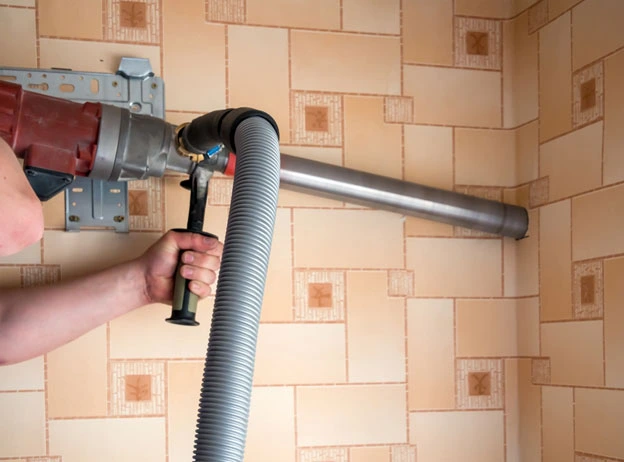
Hydraulic Core Drills
Hydraulic core drills are typically used in heavy-duty construction environments where higher power output and torque are needed. These drills are ideal for large-diameter core drilling in concrete and reinforced concrete, as they offer more consistent power and control compared to electric drills. Hydraulic systems are often used in infrastructure projects, such as drilling large openings for pipelines, conduits, or structural reinforcements.
Hydraulic drills are mounted on rigs and are ideal for large-scale drilling operations, including drilling through very thick concrete slabs, walls, or foundations. Because of their power and reliability, hydraulic core drills are commonly used in demanding construction environments such as road and bridge construction, tunneling, and large-scale building projects.
One of the key advantages of hydraulic drills is their ability to operate in wet environments, making them suitable for projects where water cooling is essential for extending the life of the diamond core bit. Additionally, hydraulic drills offer smoother operation, less vibration, and greater longevity, making them highly reliable for long-term or continuous drilling projects.
Pneumatic Core Drills
Pneumatic core drills use compressed air to power the drilling process. These drills are often used in areas where electrical power is unavailable or in hazardous environments where electric or hydraulic equipment might pose safety risks. Pneumatic drills are less common on typical construction sites but are favored in mining, tunneling, and industrial applications, where drilling through hard materials is required without the risk of electrical sparks.
Pneumatic core drills can be used in both handheld and rig-mounted setups. They are especially useful in environments where water or hydraulic fluids cannot be used, such as explosive or highly flammable locations. While pneumatic drills are not as commonly used for general construction tasks, they play a crucial role in specific industrial or underground drilling operations.
Wet vs. Dry Drilling Equipment
Wet drilling equipment uses water to cool the diamond core bit and flush out debris, reducing friction and heat buildup during the drilling process. Wet drilling extends the lifespan of the core bit and allows for longer, continuous drilling sessions. It also minimizes dust, making it a safer option for environments where dust control is important. Wet drilling is generally preferred for cutting through hard, dense materials like reinforced concrete, granite, or stone, where the bit can overheat quickly without proper cooling.
Dry drilling equipment, on the other hand, is equipped with dust extraction systems to remove debris and keep the drilling area clean. Dry drilling is typically used in situations where water cannot be used, such as indoor environments or when drilling in materials like brick or lightweight concrete. Dry drilling tends to generate more heat, which can wear out the core bit more quickly, so it's usually reserved for smaller holes or less abrasive materials.
Choosing the Right Equipment for Diamond Core Bits
The choice of drilling equipment depends on several factors, including the size of the hole, the material being drilled, the depth of the hole, and the specific requirements of the project. For small holes or light-duty drilling in materials like brick or soft concrete, handheld core drills are generally sufficient. For larger holes or more abrasive materials like reinforced concrete, rig-mounted core drills powered by electric, hydraulic, or pneumatic systems provide the power and precision needed.
Wet drilling equipment is preferred when drilling through dense or reinforced materials, as it reduces heat and dust while extending the lifespan of the core bit. Dry drilling, while less common for heavy-duty tasks, is used in environments where water cannot be applied or where dust control is critical.
Diamond Core Bit – RPM’s Affect on Performance
The RPM (Revolutions Per Minute) or drilling speed of a diamond core bit is a critical factor that directly influences its cutting performance, efficiency, and the quality of the drilled hole in concrete and construction applications. The RPM must be carefully adjusted based on the diameter of the core bit, the material being drilled, and the power of the drilling equipment. An optimal drilling speed ensures that the core bit cuts effectively, prolongs its lifespan, and prevents overheating or premature wear.
The Relationship Between Core Bit Diameter and RPM
One of the most important aspects to consider when determining the correct RPM for a diamond core bit is the diameter of the bit. Generally, as the diameter of the core bit increases, the RPM should decrease. Larger core bits cover more surface area, creating more friction and heat during drilling, so they require slower speeds to maintain effective cutting without generating excessive heat.
For example, a small-diameter core bit (e.g., 1-2 inches) can run at higher RPMs, usually between 1,000 to 3,000 RPM, depending on the material and the equipment. However, larger core bits with diameters of 6-12 inches may need to operate at much lower speeds, typically between 300 to 600 RPM, to avoid overheating and ensure steady material removal.
RPM Guidelines Based on Core Bit Diameter
-
 Small Core Bits (1-2 inches): These bits are suitable for higher RPMs, ranging from 1,000 to 3,000 RPM. They are often used in handheld drills for small-diameter holes, such as anchor bolts, electrical conduit openings, and plumbing installations. The faster RPM helps improve cutting speed in softer materials like brick and non-reinforced concrete.
Small Core Bits (1-2 inches): These bits are suitable for higher RPMs, ranging from 1,000 to 3,000 RPM. They are often used in handheld drills for small-diameter holes, such as anchor bolts, electrical conduit openings, and plumbing installations. The faster RPM helps improve cutting speed in softer materials like brick and non-reinforced concrete.
-
 Medium Core Bits (3-6 inches): For medium-sized core bits, the RPM typically ranges from 600 to 1,500 RPM, depending on the material's hardness. These bits are commonly used in rig-mounted drills for general construction tasks such as utility installations or medium-sized openings in floors or walls.
Medium Core Bits (3-6 inches): For medium-sized core bits, the RPM typically ranges from 600 to 1,500 RPM, depending on the material's hardness. These bits are commonly used in rig-mounted drills for general construction tasks such as utility installations or medium-sized openings in floors or walls.
-
 Large Core Bits (6-12+ inches): Larger core bits require much slower RPMs, typically ranging from 300 to 600 RPM. These bits are used for creating large openings in concrete slabs, walls, or reinforced structures, and the slower speed ensures that the bit does not overheat and that material is removed steadily.
Large Core Bits (6-12+ inches): Larger core bits require much slower RPMs, typically ranging from 300 to 600 RPM. These bits are used for creating large openings in concrete slabs, walls, or reinforced structures, and the slower speed ensures that the bit does not overheat and that material is removed steadily.
Material Type and RPM
The type of material being drilled also has a major influence on the required RPM. Harder materials like reinforced concrete and granite require slower drilling speeds, while softer materials like asphalt and brick can tolerate higher speeds.
-
 Reinforced Concrete: For drilling into reinforced concrete, the presence of steel rebar increases friction and resistance. Lower RPMs, often in the range of 300 to 600 RPM for larger bits, are recommended to maintain cutting efficiency while avoiding overheating. If the RPM is too high, the diamond segments can overheat, leading to rapid wear and decreased bit life.
Reinforced Concrete: For drilling into reinforced concrete, the presence of steel rebar increases friction and resistance. Lower RPMs, often in the range of 300 to 600 RPM for larger bits, are recommended to maintain cutting efficiency while avoiding overheating. If the RPM is too high, the diamond segments can overheat, leading to rapid wear and decreased bit life.
-
 Non-Reinforced Concrete, Brick, and Asphalt: These materials are less abrasive and can be drilled at higher speeds. RPMs between 1,000 to 2,000 for smaller bits and 500 to 1,000 for medium-sized bits are common. The higher RPM allows for faster material removal without causing significant wear on the bit.
Non-Reinforced Concrete, Brick, and Asphalt: These materials are less abrasive and can be drilled at higher speeds. RPMs between 1,000 to 2,000 for smaller bits and 500 to 1,000 for medium-sized bits are common. The higher RPM allows for faster material removal without causing significant wear on the bit.
-
 Granite and Hard Stone: Hard stone materials, such as granite, require slower RPMs to ensure smooth, steady cutting. In general, RPMs for granite drilling are on the lower side, similar to reinforced concrete, to prevent the bit from overheating and to maximize its cutting efficiency.
Granite and Hard Stone: Hard stone materials, such as granite, require slower RPMs to ensure smooth, steady cutting. In general, RPMs for granite drilling are on the lower side, similar to reinforced concrete, to prevent the bit from overheating and to maximize its cutting efficiency.
RPM and Drilling Depth
The depth of the hole being drilled also affects the optimal RPM. For shallow drilling, higher RPMs may be effective because the bit does not generate excessive heat over a short distance. However, as the depth of the hole increases, especially when drilling through thick slabs or walls, heat buildup becomes more of a concern. In such cases, the RPM should be reduced as the depth increases, ensuring that the bit can continue cutting efficiently without becoming excessively hot.
Cooling systems, such as water in wet drilling applications, help manage heat during deeper drilling. The cooling effect allows the core bit to operate at slightly higher RPMs for deeper cuts than would be possible in dry drilling conditions.
Wet Drilling vs. Dry Drilling RPM
In wet drilling, water is used to cool the diamond core bit and remove debris. The cooling provided by the water allows for slightly higher RPMs since the bit is less likely to overheat. Wet drilling is preferred in most construction applications, particularly when drilling through tough materials like reinforced concrete. By preventing heat buildup, wet drilling allows the core bit to maintain a consistent cutting speed and extend its lifespan.
In dry drilling, no water is used, and the core bit must operate at lower RPMs to avoid overheating. Dry drilling generates more friction and heat, which can quickly wear out the core bit if the RPM is too high. As a result, the RPM for dry drilling is generally reduced by about 20-30% compared to wet drilling.
Effects of Incorrect RPM
Using the wrong RPM for the core bit and material being drilled can lead to several issues:
-
 Excessive Wear: If the RPM is too high, the diamonds and bond material in the core bit may wear out prematurely due to excessive heat and friction. This reduces the lifespan of the bit and increases operating costs.
Excessive Wear: If the RPM is too high, the diamonds and bond material in the core bit may wear out prematurely due to excessive heat and friction. This reduces the lifespan of the bit and increases operating costs.
-
 Overheating: High RPMs can cause the core bit to overheat, especially in dry drilling or when drilling into hard materials like granite or reinforced concrete. Overheating damages the bit and can cause it to lose its cutting efficiency.
Overheating: High RPMs can cause the core bit to overheat, especially in dry drilling or when drilling into hard materials like granite or reinforced concrete. Overheating damages the bit and can cause it to lose its cutting efficiency.
-
 Slower Drilling: If the RPM is too low for the size of the core bit or material, the drilling process becomes inefficient, resulting in slower cutting speeds and longer project times. Lower RPMs reduce productivity, especially in softer materials where higher speeds would be more effective.
Slower Drilling: If the RPM is too low for the size of the core bit or material, the drilling process becomes inefficient, resulting in slower cutting speeds and longer project times. Lower RPMs reduce productivity, especially in softer materials where higher speeds would be more effective.
-
 Chipping or Uneven Cuts: In some cases, incorrect RPMs can cause chipping or uneven cutting. If the RPM is too fast, especially in hard materials, it can cause the bit to grab or chip the edges of the hole.
Chipping or Uneven Cuts: In some cases, incorrect RPMs can cause chipping or uneven cutting. If the RPM is too fast, especially in hard materials, it can cause the bit to grab or chip the edges of the hole.
RPM and Operator Skill
The experience and skill of the operator also play a role in determining the ideal RPM. Experienced operators can adjust the RPM on the fly, responding to changing conditions such as increased friction, the presence of rebar, or deeper drilling. The ability to listen to the core bit and sense when the RPM needs to be adjusted is an important skill in maximizing the performance of diamond core bits in concrete and construction projects.
Diamond Core Bit – Horse Power Affect on Performance
The horsepower (HP) of a drilling machine is a key factor in determining its ability to handle different types of diamond core bits for concrete and construction applications. Horsepower is a measurement of the power output of the drilling equipment, which directly affects the torque, drilling speed, and overall efficiency of the operation. The right amount of horsepower ensures that the machine can maintain a steady drilling rate, handle the resistance of hard materials, and operate larger core bits effectively without stalling or losing power.

The Role of Horsepower in Core Drilling
In diamond core drilling, horsepower translates to the machine’s capacity to drive the core bit through tough materials like concrete, masonry, and reinforced concrete. Higher horsepower allows the equipment to generate more torque (rotational force), which is crucial for overcoming resistance, especially when drilling large-diameter holes or penetrating hard materials.
Torque is particularly important for maintaining consistent cutting pressure on the bit, which helps prevent it from slowing down or stalling during difficult drilling conditions. Machines with insufficient horsepower may struggle to maintain the necessary torque, especially when encountering steel rebar or dense aggregates, resulting in slower drilling speeds, increased wear on the bit, and potential equipment failure.
Horsepower and Core Bit Diameter
Horsepower requirements increase with the diameter of the core bit. Larger core bits require more power to cut through the material efficiently due to their greater surface area and the higher amount of friction generated during drilling. Smaller core bits, on the other hand, can be driven by machines with lower horsepower, as they encounter less resistance and require less torque to maintain drilling speed.
-
 Small Core Bits (1-2 inches): For small-diameter core bits, typically used in handheld or portable core drills, machines with 1 to 2 HP are sufficient. These bits require less torque, allowing the equipment to run at higher RPMs. Smaller core bits are used for light-duty drilling in materials like brick, block, or non-reinforced concrete.
Small Core Bits (1-2 inches): For small-diameter core bits, typically used in handheld or portable core drills, machines with 1 to 2 HP are sufficient. These bits require less torque, allowing the equipment to run at higher RPMs. Smaller core bits are used for light-duty drilling in materials like brick, block, or non-reinforced concrete.
-
 Medium Core Bits (3-6 inches): For medium-sized core bits, drilling machines need around 2 to 5 HP to provide the necessary torque for efficient cutting. These bits are commonly used for creating medium-sized holes in concrete walls, floors, or slabs for plumbing, electrical conduit, or anchor installations. The additional horsepower ensures that the machine can maintain steady drilling pressure even when cutting through harder materials like reinforced concrete.
Medium Core Bits (3-6 inches): For medium-sized core bits, drilling machines need around 2 to 5 HP to provide the necessary torque for efficient cutting. These bits are commonly used for creating medium-sized holes in concrete walls, floors, or slabs for plumbing, electrical conduit, or anchor installations. The additional horsepower ensures that the machine can maintain steady drilling pressure even when cutting through harder materials like reinforced concrete.
-
 Large Core Bits (6-12+ inches): Larger core bits require significantly more horsepower to maintain torque and cutting speed. Machines with 5 to 10+ HP are typically required for these heavy-duty tasks. Large core bits are used in rig-mounted drills for creating large openings in concrete slabs, structural walls, and foundations. The high power output ensures the bit can cut through both concrete and embedded rebar without slowing down or losing efficiency.
Large Core Bits (6-12+ inches): Larger core bits require significantly more horsepower to maintain torque and cutting speed. Machines with 5 to 10+ HP are typically required for these heavy-duty tasks. Large core bits are used in rig-mounted drills for creating large openings in concrete slabs, structural walls, and foundations. The high power output ensures the bit can cut through both concrete and embedded rebar without slowing down or losing efficiency.
Horsepower and Material Type
The material being drilled also influences the horsepower requirements. Harder materials, such as reinforced concrete or granite, generate more resistance and require more power to drill through effectively. In contrast, softer materials like asphalt or non-reinforced concrete can be drilled with lower horsepower machines, as these materials offer less resistance.
-
 Reinforced Concrete: Drilling through reinforced concrete, which often includes steel rebar, demands a machine with higher horsepower. Machines with 3 to 10 HP are commonly used for reinforced concrete drilling, depending on the size of the bit. The higher power output allows the machine to maintain consistent torque when the bit encounters rebar, which is much harder and denser than concrete alone.
Reinforced Concrete: Drilling through reinforced concrete, which often includes steel rebar, demands a machine with higher horsepower. Machines with 3 to 10 HP are commonly used for reinforced concrete drilling, depending on the size of the bit. The higher power output allows the machine to maintain consistent torque when the bit encounters rebar, which is much harder and denser than concrete alone.
-
 Non-Reinforced Concrete, Brick, and Asphalt: Softer materials like non-reinforced concrete, brick, and asphalt can typically be drilled with machines in the 1 to 5 HP range, depending on the bit diameter. These materials do not require as much torque or power to cut through, allowing for faster drilling speeds with less power.
Non-Reinforced Concrete, Brick, and Asphalt: Softer materials like non-reinforced concrete, brick, and asphalt can typically be drilled with machines in the 1 to 5 HP range, depending on the bit diameter. These materials do not require as much torque or power to cut through, allowing for faster drilling speeds with less power.
-
 Granite and Hard Stone: Drilling through granite or other hard stone requires substantial power due to the high level of resistance these materials present. Machines with 5 to 10 HP or more are needed for efficient drilling, particularly when using larger core bits. Higher horsepower ensures that the bit can penetrate the material without stalling or overheating.
Granite and Hard Stone: Drilling through granite or other hard stone requires substantial power due to the high level of resistance these materials present. Machines with 5 to 10 HP or more are needed for efficient drilling, particularly when using larger core bits. Higher horsepower ensures that the bit can penetrate the material without stalling or overheating.
Horsepower and Drilling Depth
Drilling depth is another factor that influences horsepower requirements. As the depth of the hole increases, especially in thick concrete slabs or walls, the resistance encountered by the core bit also increases. The deeper the bit goes, the more torque is required to maintain steady cutting pressure. Machines with higher horsepower are better equipped to handle deep drilling because they can sustain the torque necessary to cut through dense materials over long distances without losing speed.
For deep drilling applications, machines with 5 to 10 HP or more are typically recommended, especially when drilling into hard materials like reinforced concrete. The extra horsepower ensures that the machine can continue drilling effectively as the hole deepens, preventing overheating or tool failure.
Wet Drilling vs. Dry Drilling and Horsepower
In wet drilling, water is used to cool the core bit and flush out debris, which helps reduce the friction and heat generated during drilling. Wet drilling can be performed with machines in the 1 to 10+ HP range, depending on the material and bit size. The cooling effect of water allows for more efficient drilling, as it reduces wear on the bit and the machine.
In dry drilling, where no water is used, the machine must have higher horsepower to compensate for the increased friction and heat. Machines with higher horsepower, generally around 5 to 10 HP, are often required for dry drilling in hard materials like concrete or stone. The extra power helps the machine maintain torque and speed without overheating, even though dry drilling generates more friction.
Horsepower and Operator Control
Machines with higher horsepower provide more control over the drilling process, especially in challenging materials. However, higher horsepower equipment also requires experienced operators who understand how to manage the power output effectively. Misuse of high-powered drilling machines can lead to tool damage, overheating, or safety issues if not handled properly.
Experienced operators are able to adjust drilling speed, torque, and pressure to match the material and application, ensuring that the machine’s horsepower is fully utilized without overloading the equipment or the bit. Operators must also monitor the machine’s performance to avoid stalling, especially when drilling through materials with variable density, such as reinforced concrete with steel rebar.
Effects of Insufficient Horsepower
Using a machine with insufficient horsepower for the task can result in several issues:
-
 Stalling: Without enough horsepower, the machine may stall when the bit encounters high resistance, such as steel rebar or dense aggregates. This can lead to incomplete drilling and the need to restart the operation.
Stalling: Without enough horsepower, the machine may stall when the bit encounters high resistance, such as steel rebar or dense aggregates. This can lead to incomplete drilling and the need to restart the operation.
-
 Overheating: Machines with low horsepower may overheat more quickly when drilling into hard or abrasive materials, especially if dry drilling is used. Overheating can damage the motor, the core bit, and the material being drilled.
Overheating: Machines with low horsepower may overheat more quickly when drilling into hard or abrasive materials, especially if dry drilling is used. Overheating can damage the motor, the core bit, and the material being drilled.
-
 Slow Drilling: Insufficient horsepower reduces the torque available to drive the core bit through the material, leading to slower cutting speeds and longer project times.
Slow Drilling: Insufficient horsepower reduces the torque available to drive the core bit through the material, leading to slower cutting speeds and longer project times.
-
 Increased Wear on Core Bit: When the machine struggles to maintain torque, the core bit experiences uneven wear, reducing its lifespan and increasing costs for bit replacements.
Increased Wear on Core Bit: When the machine struggles to maintain torque, the core bit experiences uneven wear, reducing its lifespan and increasing costs for bit replacements.
Understanding Tradeoffs for Diamond Core Performance
When selecting diamond core bits for concrete and construction applications, understanding the trade-offs is crucial to optimizing performance, efficiency, and cost-effectiveness. Every diamond core bit has its strengths and limitations, and choosing the right one often involves balancing several factors such as cutting speed, durability, precision, cost, and material compatibility. Being aware of these trade-offs allows contractors, engineers, and builders to make informed decisions that align with the specific needs of their projects. Below are some key trade-offs that should be considered when choosing diamond core bits.
1. Cutting Speed vs. Bit Longevity
One of the most significant trade-offs in diamond core bits is the balance between cutting speed and bit longevity. Core bits with coarser diamond grit and softer bonds tend to cut faster because they allow fresh diamond particles to be exposed quickly. However, the trade-off is that these bits wear out more rapidly, especially when used in abrasive materials like reinforced concrete or granite. This makes them suitable for projects where speed is a priority but can result in frequent bit replacements.
On the other hand, core bits with finer diamond grit and harder bonds have a longer lifespan. They wear down more slowly, preserving the diamonds for a longer period, but the slower wear rate reduces the cutting speed. These bits are better for long-term projects where durability is more important than speed, but they can be inefficient in projects requiring quick turnaround times.
Key Consideration: Faster cutting bits are ideal for time-sensitive projects but require frequent replacement. Longer-lasting bits save on replacement costs but may slow down the drilling process.


2. Cost vs. Quality
Another key trade-off revolves around the cost of the diamond core bit and its quality. Lower-cost core bits are typically made with lower-grade diamonds, softer bonds, or less durable materials. While these bits are more affordable upfront, they tend to wear out more quickly, particularly in tough, abrasive materials like reinforced concrete.
High-quality core bits, made with premium synthetic diamonds and stronger bond compositions, may cost more initially but offer better performance, longer tool life, and increased precision. This reduces downtime due to bit replacements and can lower overall costs in the long run, especially for larger or more demanding projects.
Key Consideration: Cheaper bits can be cost-effective for short-term or less demanding projects, but higher-quality bits offer better longevity and performance, saving costs in the long term.
3. Material Specificity vs. Versatility
Diamond core bits are often designed with specific materials in mind, such as reinforced concrete, asphalt, brick, or granite. A core bit optimized for a specific material will provide excellent performance in that material but may underperform in other types of materials. For instance, a core bit designed for cutting asphalt may not handle the toughness of reinforced concrete very well.
Alternatively, versatile core bits are designed to work reasonably well across a range of materials. However, they may not deliver the same level of performance as material-specific bits in challenging conditions. Customers who face a variety of materials on-site often need to balance the advantages of versatility with the benefits of optimized, material-specific performance.
Key Consideration: Material-specific bits excel in performance for specific materials but may be inefficient in other applications, whereas versatile bits offer convenience but at the cost of peak performance in specialized conditions.
4. Wet Drilling vs. Dry Drilling
Wet drilling and dry drilling both come with their own sets of trade-offs. Wet drilling is generally preferred because it allows for faster drilling, reduced friction, and better cooling of the diamond segments, which extends the life of the core bit. Wet drilling also reduces dust, making it safer for workers and compliant with environmental regulations on dust control.
However, wet drilling requires access to water and proper disposal of the slurry created during the process, which can complicate logistics. In contrast, dry drilling is simpler in terms of setup and doesn't require water or slurry disposal, making it ideal for indoor or confined-space applications. However, the downside is that dry drilling generates more heat, which can lead to faster wear of the core bit and may require slower drilling speeds to prevent overheating.
Key Consideration: Wet drilling offers better performance and bit longevity but requires more logistical planning, while dry drilling is simpler but can wear out bits faster due to increased heat and friction.

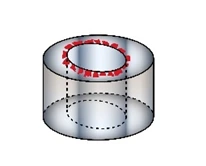
5. Cutting Speed vs. Surface Finish Quality
Another important trade-off is between cutting speed and the quality of the surface finish. Core bits with coarser diamond grit are designed for fast, aggressive cutting, which is ideal for large projects requiring quick material removal, such as drilling holes for pipes, electrical conduits, or utility installations. However, this can lead to a rougher surface finish and may result in chipping or uneven edges.
Finer diamond grit sizes, on the other hand, provide a smoother finish, making them ideal for precision drilling in applications where appearance and accuracy are important, such as architectural projects or finishing work. The trade-off is that these bits cut more slowly, increasing the time needed to complete the job.
Key Consideration: Coarse grit bits provide faster cutting but may result in a rougher finish, while finer grit bits ensure a smooth finish but require more time to complete the task.
6. Horsepower Requirements vs. Bit Compatibility
The horsepower of the drilling machine must be matched to the size and type of diamond core bit. Large core bits require higher horsepower to generate the torque necessary to cut through dense materials, such as reinforced concrete or granite. However, high-horsepower machines are more expensive, heavier, and more complex to operate.
On the other hand, smaller core bits can be used with lower-horsepower machines, which are typically less costly and easier to handle. The trade-off here is that smaller bits and lower horsepower may not be sufficient for large-scale projects or for drilling through tough, reinforced materials.
Key Consideration: Larger core bits require more powerful equipment but are necessary for heavy-duty tasks. Smaller bits work well with lower-horsepower machines but are limited in their capacity for larger projects.


7. Operator Experience vs. Equipment Complexity
Highly specialized diamond core bits and drilling equipment often require skilled operators to achieve optimal performance. Bits with advanced features like variable bond compositions, finer diamond grit, or customized segments are best suited for experienced professionals who can adjust drilling speed, pressure, and cooling methods based on the material being drilled.
However, simpler core bits and equipment can be more accessible to less experienced operators, although they may not offer the same level of precision or performance. The trade-off is between the ease of use for beginners versus the higher performance potential that skilled operators can achieve with more complex tools.
Key Consideration: Experienced operators can maximize the potential of high-performance bits, while simpler bits may be better suited for less experienced operators but offer less precision and flexibility.
Here is a table that compares trade-offs for selecting diamond core bits
|
Trade-Off |
Option 1 |
Option 2 |
Key Consideration |
|---|---|---|---|
|
Cutting Speed vs. Bit Longevity |
Faster Cutting: Coarser grit, softer bond, faster material removal |
Longer Bit Life: Finer grit, harder bond, slower cutting |
Faster bits wear out quickly, long-lasting bits cut slower |
|
Cost vs. Quality |
Lower Cost: Cheaper upfront, faster wear |
Higher Quality: Higher cost, better performance and durability |
Low-cost bits are for short-term savings, high-quality bits save money long-term |
|
Material Specificity vs. Versatility |
Material-Specific: Optimized for one material |
Versatile: Works reasonably well across multiple materials |
Material-specific bits perform better, versatile bits are convenient |
|
Wet Drilling vs. Dry Drilling |
Wet Drilling: Better cooling, less dust, longer bit life |
Dry Drilling: Easier setup, no water needed |
Wet drilling is more efficient, dry drilling is simpler but may wear bits faster |
|
Cutting Speed vs. Surface Finish |
Faster Cutting: Coarser grit, rougher finish |
Smoother Finish: Finer grit, slower cutting |
Coarse bits are faster but leave a rough finish, fine bits offer precision |
|
Horsepower Requirements vs. Bit Compatibility |
Higher Horsepower: Necessary for large bits, higher cost |
Lower Horsepower: Compatible with smaller bits, less powerful |
High horsepower is needed for large bits, low horsepower for smaller bits |
|
Operator Experience vs. Equipment Complexity |
Advanced Equipment: Higher performance but requires skilled operator |
Simple Equipment: Easier to use, less performance |
Complex bits maximize performance but need experience to use correctly |
|
Initial Cost vs. Long-Term Investment |
Lower Initial Cost: More frequent replacements |
Higher Long-Term Value: Longer bit life, fewer replacements |
Cheap bits save money short-term, higher-quality bits save money long-term |
|
Durability vs. Flexibility |
Durable: Designed for specific materials, longer lasting |
Flexible: Works across different materials, more adaptable |
Durable bits excel in specific applications, flexible bits work across multiple materials |
|
Segment Design vs. Application Needs |
Fast Cutting: Turbo or serrated segments, faster drilling |
Precision: Continuous rim, smoother cuts |
Turbo segments for speed, continuous rims for smoother, more precise cuts |
|
Cooling Efficiency vs. Bit Performance |
Wet Drilling: Longer bit life, better cooling |
Dry Drilling: Convenient setup but more wear |
Wet drilling is more efficient, dry drilling requires heat management |

Brian is an experienced professional in the field of precision cutting tools, with over 27 years of experience in technical support. Over the years, he has helped engineers, manufacturers, researchers, and contractors find the right solutions for working with advanced and hard-to-cut materials. He’s passionate about bridging technical knowledge with real-world applications to improve efficiency and accuracy.
As an author, Brian Farberov writes extensively on diamond tool design, application engineering, return on investment strategies, and process optimization, combining technical depth with a strong understanding of customer needs and market dynamics.
ARE YOU USING DIAMOND CORE BITS
FOR YOUR APPLICATION?
LET US
HELP YOU
HAVING ISSUES WITH
YOUR CURRENT DIAMOND CORE BITS?
Knowledge Center
Diamond Core Bit Ultimate Guide
Concrete Drilling Metrics – Optimizing your Diamond Core Bit
Optimal Drilling Performance – How to Properly Use Diamond Core Bits
Select Right Diamond Drill for your Application
How to Properly Use Precision Diamond Drills
Diamond Drills Guide
Diamond Tools Guide – Selecting Right Drills & Tools for your application
Optimizing your Diamond Drilling Operation
Diamond Core Drill & Drill Trouble Shooting Guide
Understanding & Calculating Return on Investment for Diamond Core Drills & Other Tools
Understanding Tradeoffs – Searching for Perfect Diamond Drill & Tool

Brian is an experienced professional in the field of precision cutting tools, with over 27 years of experience in technical support. Over the years, he has helped engineers, manufacturers, researchers, and contractors find the right solutions for working with advanced and hard-to-cut materials. He’s passionate about bridging technical knowledge with real-world applications to improve efficiency and accuracy.
As an author, Brian Farberov writes extensively on diamond tool design, application engineering, return on investment strategies, and process optimization, combining technical depth with a strong understanding of customer needs and market dynamics.















































